PGA Tour Release Styles
September 2010
- by Kelvin Miyahira
After taking and reviewing hundreds of videos showing impact positions and release movements of tour players, it is becoming rather obvious that there is more than one way to strike a golf ball. I have written a lot about how Tiger used to hit the ball in the past (and still feel that it is a superior method), but even he is changing how he is hitting the ball. In 2009, Haney changed Tiger’s swing during his rehabilitation from knee surgery. Recent changes in his swing with Sean Foley are making him swing the club differently through impact as well.
Thus, while his impact position is roughly the same, how he is getting to that position and how the hands/club move post-impact are changing. This necessitated a study on more than the overly simplistic view of impact position, but a more complex and broader view of release style or method which takes into account hand position prior to impact, clubface positioning, rate of clubface closing, shaft angle at impact (forward lean or more vertical), movement of hands through impact as well as arm and body movements.
Now, part of the difficulty in doing this is that I have to make “arbitrary” assessments based on positions of the hands, club and shaft angle. I must apologize that some of these swings are driver or fairway wood swings and some are iron shots. Also, some are on course swings and some are driving range swing. So a perfect scientific study, this is not. However, it’s the best we can do and I’m sure it’s plenty good enough for everyone to learn something from.
Some of you may or may not agree with the category your favorite golfer is placed in but it should not matter since being on tour means whatever method being used is certainly good enough to be used on the PGA tour in the first place. And that means, if you sort of look like one of these guys and hit the ball well, then by all means, just keep on doing it.
But if you’re looking for better contact and more accuracy, there are some things you can do to make each method work for you, even if you’re a flipper! So, let’s forget all you’ve been told about how to strike a golf ball and let’s just look at how the many different ways the guys on the PGA tour are doing it. This will be fascinating for some and tiring for others. The bottom line is that there are lessons to be learned by seeing what the PGA guys actually do versus what teachers say they do or what their teachers say you should do.
Let me start by first explaining how I’ve looked at the critical positions that I used to help differentiate each method so that I could start categorizing.
Note: There are some golfers that I could not recognize so instead of guessing and mistaking people, I will leave their names blank.
Critical Positions
There are three positions. They are: hands before impact, impact position and post impact position. At each position, there are different positions the hands/wrist can be in, the shaft can be in, and the left arm/forearm can be in. This might be a bit complicated as I’ve said so let’s use pictures instead of words.
Pre-impact
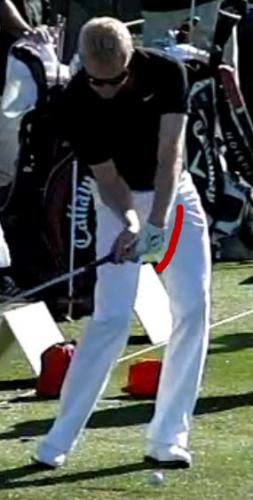
Bowed – Simon Dyson above. Notice the appearance of left wrist. It is curved and the palm is beginning to face up or supinate. In addition, he had his left wrist bone beginning to bow or enter into flexion. The bowed position is actually a combination of left wrist flexion and supination. Thus, for the sake of simplicity, the bowed position means a high amount of supination and flexion.
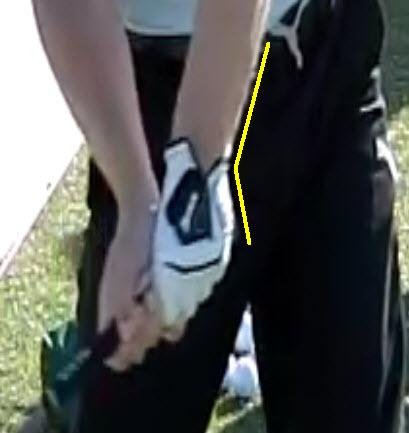
Cupped - See the cupping of Soren Kjeldsen’s left wrist? The left forearm and the pinky side of his left hand form an angle as shown by yellow lines. This means the left wrist is in a pronated position or the palm facing down as well as the left wrist is in extension.
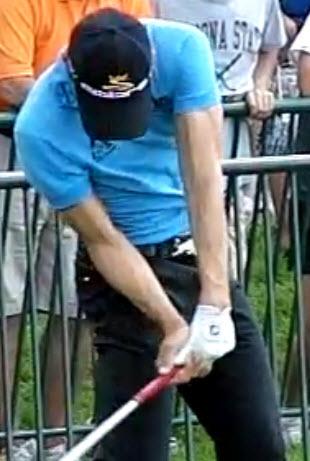
Flat – Camilo Villegas has a flat left wrist prior to impact. The left wrist is moving toward bowing but not fully bowed yet. And his palm is halfway between supinated and pronated position or a neutral position.
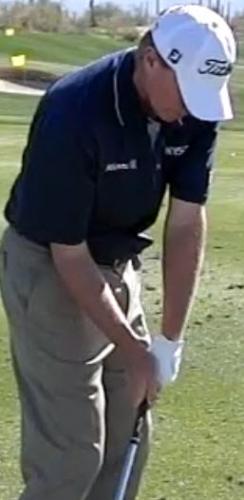
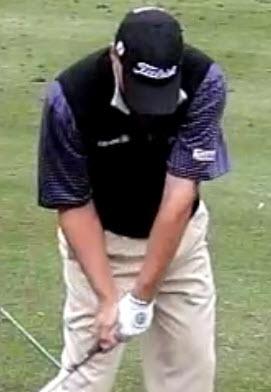
Flat – Steve Stricker from front view, the flat wrist can also look like it is slightly cupped. From an angled view, we can see that it is indeed flat. So instead of confusing the issues more, we shall say it is flat when it looks slightly cupped or if the left wrist bone is just slightly into flexion.
Impact
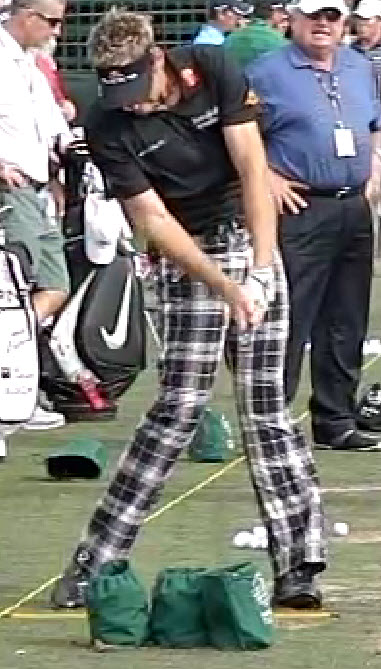
Bowed wrist – once again the bowed position is a combination of the left wrist flexion and supination as Ian Poulter shows.
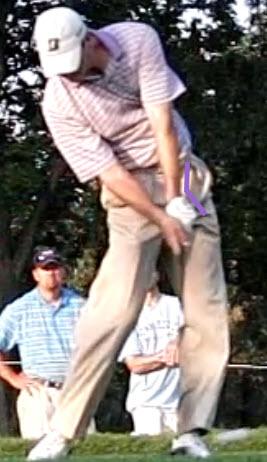
Cupped wrist – as shown by Matt Kuchar, there is a distinct angle between left forearm and back of the wrist as shown by the lavender lines.
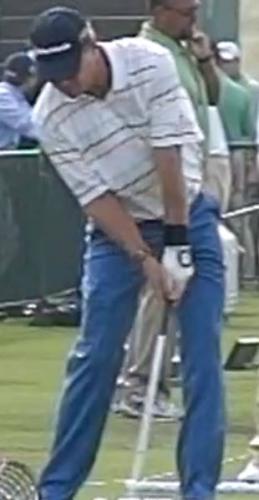
Flat wrist – is between bowed and the slightly cupped as Scott Verplank shows.
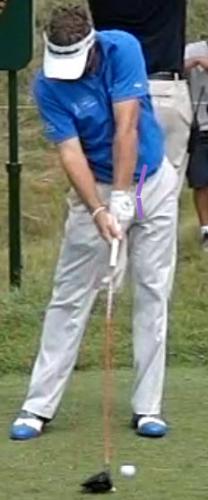
Flat wrist will also include those that appear slightly cupped. As in the pre-impact position, a wrist that is between cupped and bowed will be considered flat as Brian Gay demonstrates.
Post-impact position/movement
The post-impact position needs to be thought of differently since it is far more complex and is comprised of several different movements.
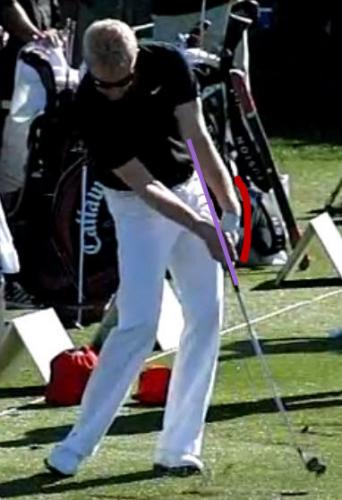
Bowed/driving – this is the exaggerated post impact position of Simon Dyson. It is characterized by the bowed wrist and the shaft staying aligned toward the left shoulder as depicted by the lavender line. Rotation of the arms is lessened by the extension of the left arm away from the chest.
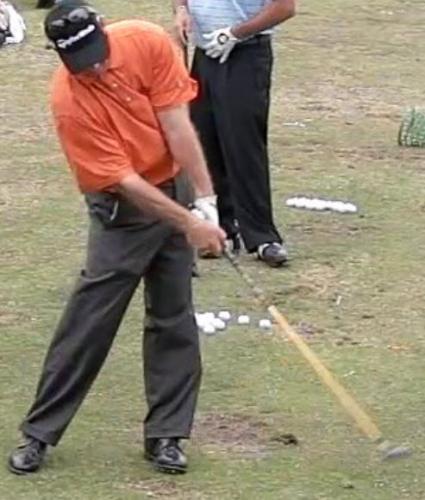
Bowed/Rolling – typically paired with a cupped wrist prior to impact (and oddly enough with Rod Pampling who is bowed pre-impact), the left arm rolls or rotates faster than the body rotation. Contrast to the bowed/driving movement which attempts to reduce left arm rotation by driving away from the body.
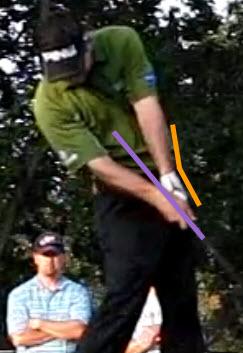
A Flip shall be defined by the clubshaft passing the left forearm and the left wrist cupping. Contrast the shaft pointing to the middle of the chest instead of toward the left forearm with DH’ers.
Pro Release Types
After I defined the positions, I started looking at the release patterns of the pros. Distinct patterns began to emerge and thus, I was able to categorize the pros by their characteristic patterns of movements from pre to post impact. There are three major categories of release types/patterns and over 20 sub-categories that we shall explain in another article should I find the need to. The three categories of release types are: Drive/Holders, Rollers, and Flippers.
What is important to note is that each and every one of these methods work or these players would not be on tour, much less win PGA tour events or any of the majors. So please do not take offense to the term “flipper” since two of this year’s majors were won by flippers.
Drive/Holders
The majority of PGA tour pros are in the drive/holding category. The drive/holders (DH) are characterized by an impact position that is steady through post-impact phase. The left wrist remains solid or moves toward a more solid position while the body provides the rotational force through the impact area. Typically, DH’ers separate their left arm from their chest while also extending their arms in the post impact area. This is especially important since this allows the bottom of the swing arc to be farther in front the ball as well as provide stability for contact.
DH’ers tend to have the most forward shaft lean and therefore hit their irons lower and farther than others. The pre-impact and impact positions of the DH pros are varied. Some are bowed, some are flat and some are cupped. It does not matter which position they are in. They can drive and hold from a bowed, flat or cupped wrist position.
So I’ve divided the Dh’ers into three subcategories by their wrist position through impact and post-impact. First, we’ll look at the bowed DH’ers, second we’ll look at cupped DH’ers and last we’ll look at flat wrist DH’ers.
Bowed DH’ers
Note: The key determinant of being a bowed DH’er is whether the wrist is in a bowed position or moving toward a bowed position through impact. Thus, some are bowed prior to impact, while others are flat but moving toward the bowed position. As long as the movement is toward the bowed position, it seems to stabilize the impact.
Another characteristic trait of the DH’er is that the shaft does not pass the left forearm until very late in the swing. This would be good to compare against the flippers that allow the shaft to pass their left forearm before impact.
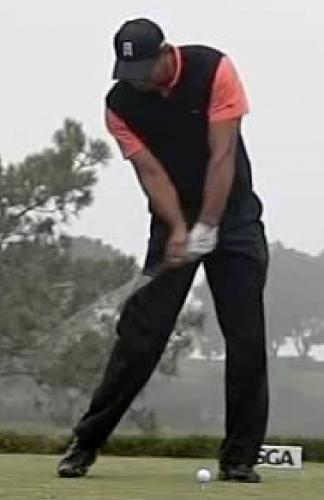
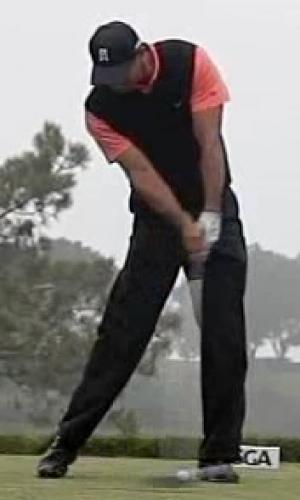
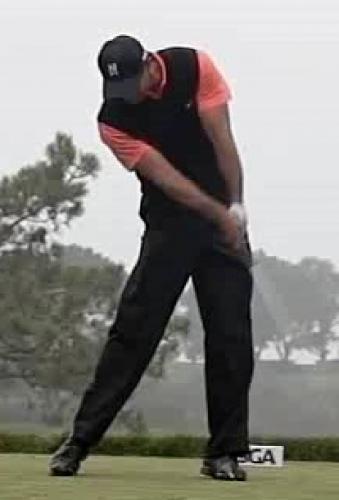
Tiger ‘08
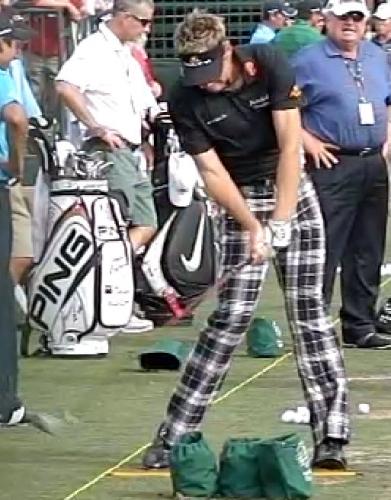
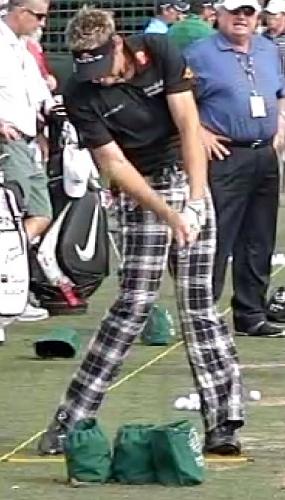
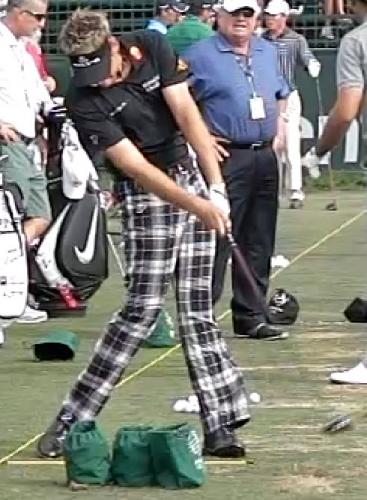
Ian Poulter
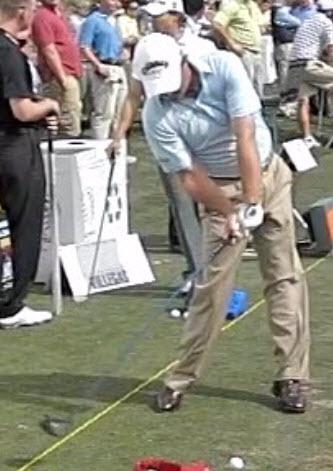
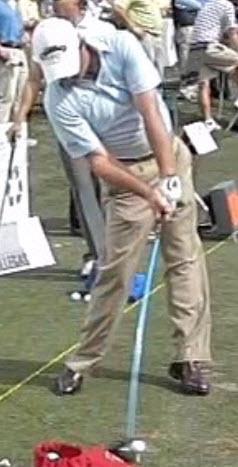
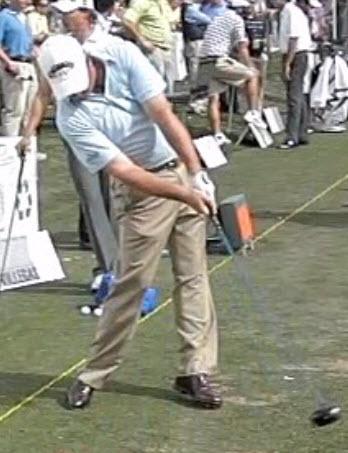
Graeme McDowell
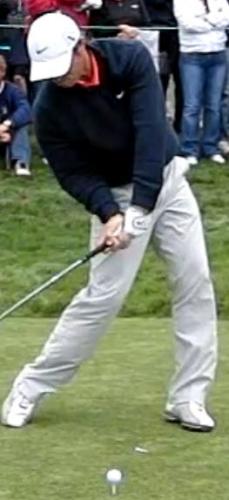
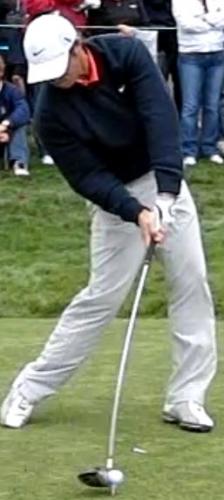
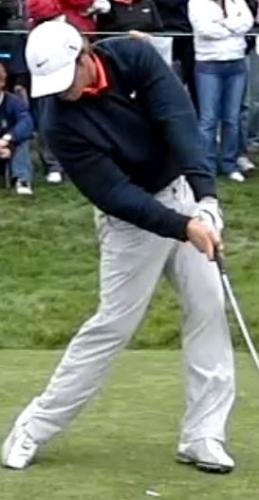
Pablo Martin
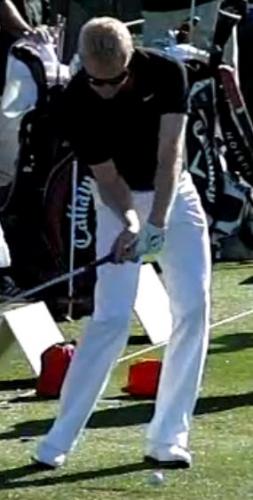
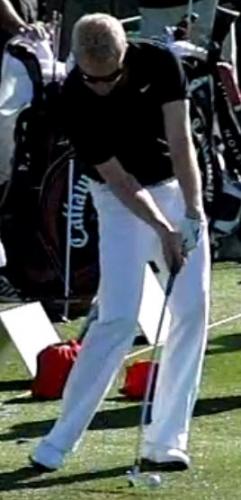
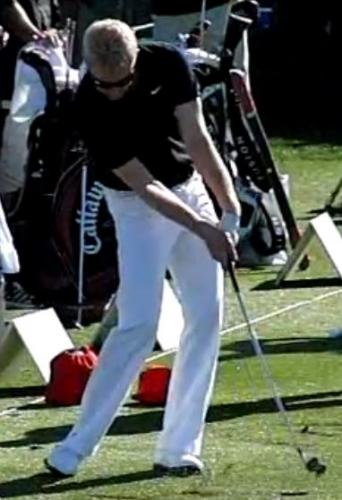
Simon Dyson
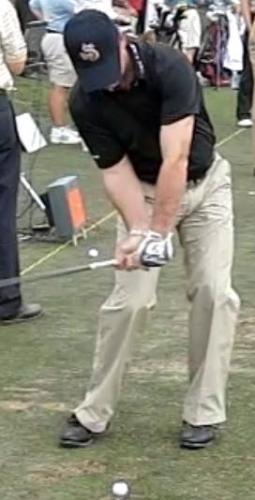
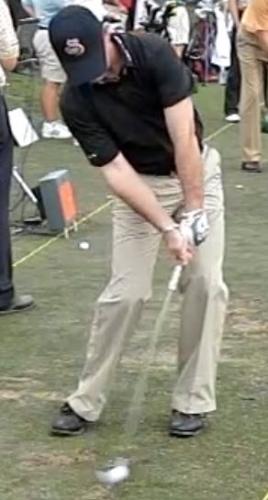
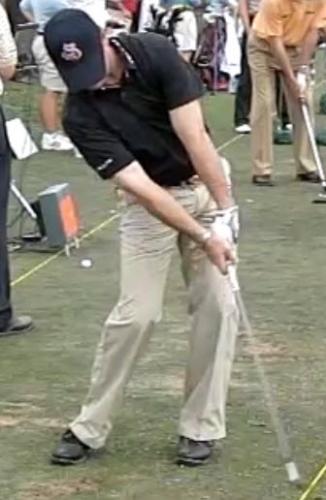
Rory Sabbatini
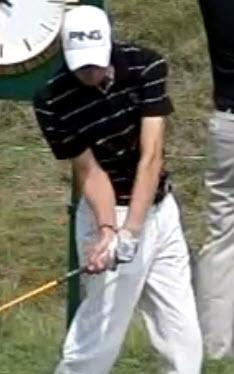
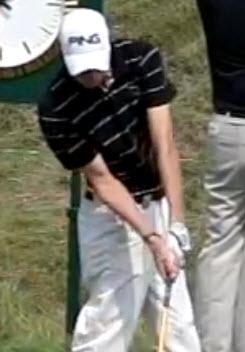
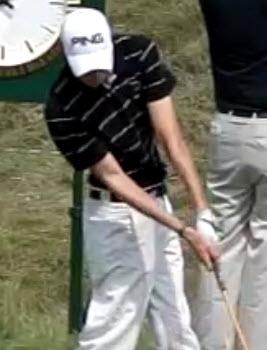
Rhys Davies
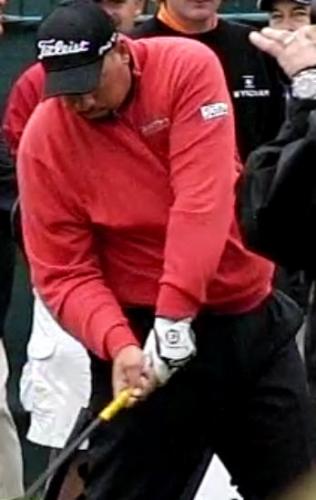
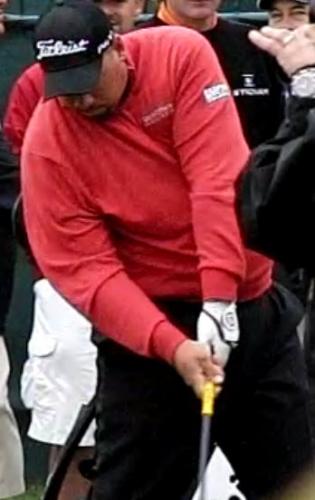
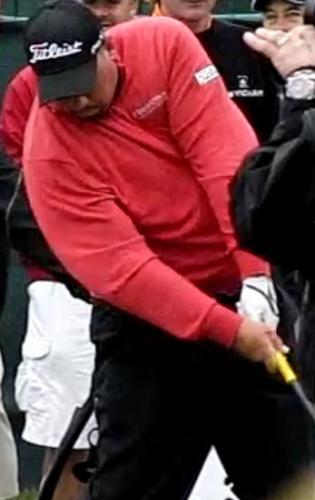
Brandon de Jonge
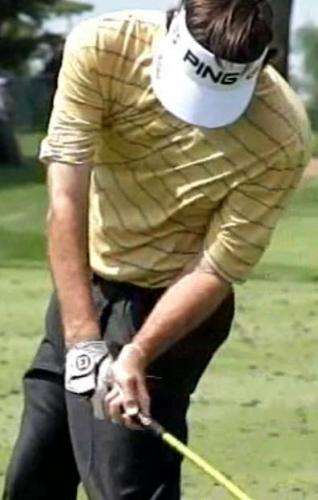
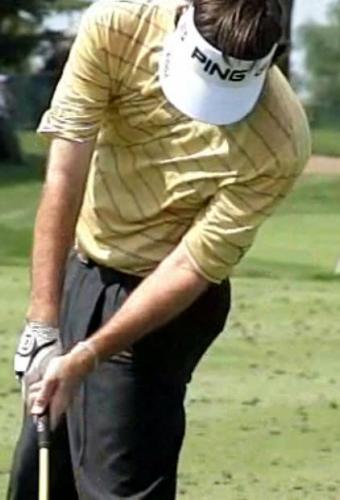
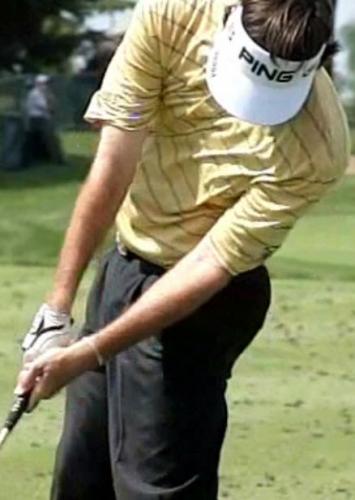
Bubba Watson
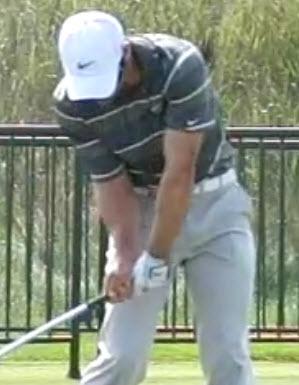
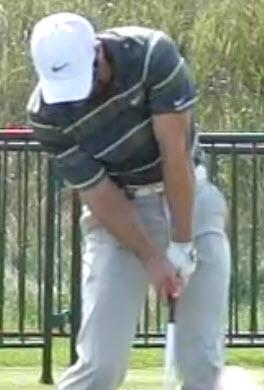
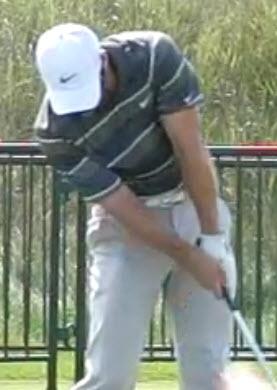
Paul Casey
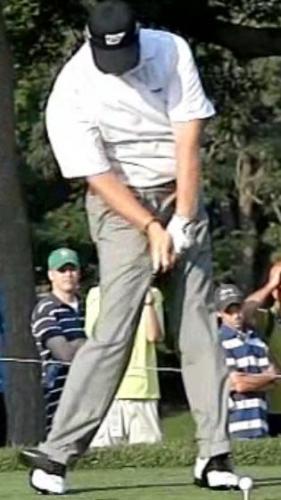
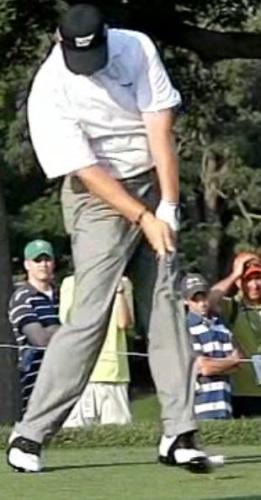
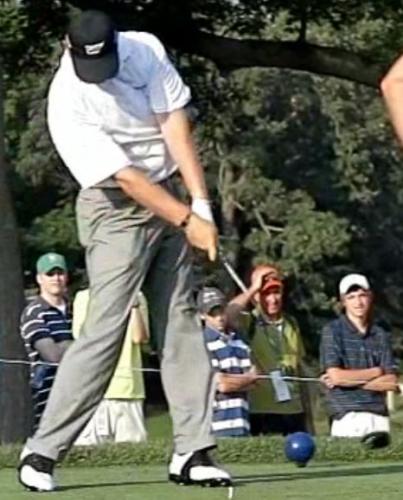
Ernie Els
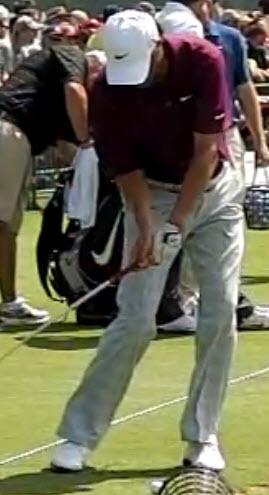

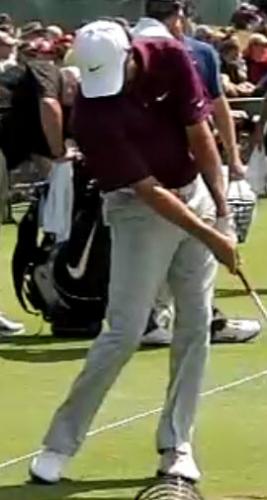
Stephen Ames
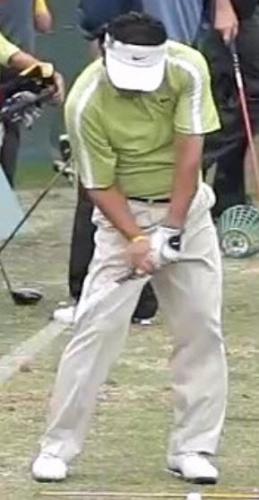

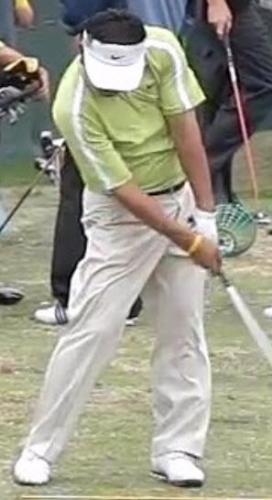
KJ Choi
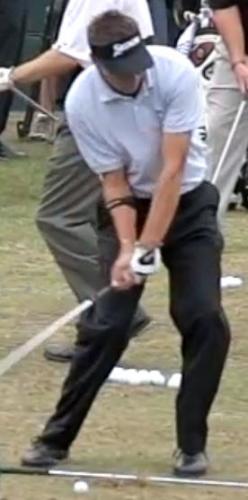
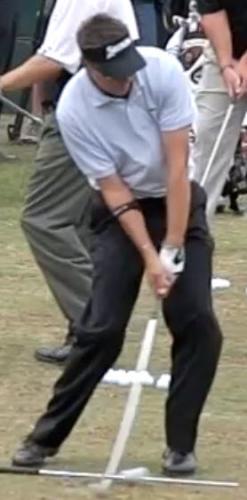
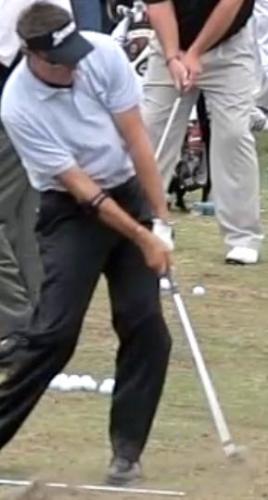
Robert Allenby
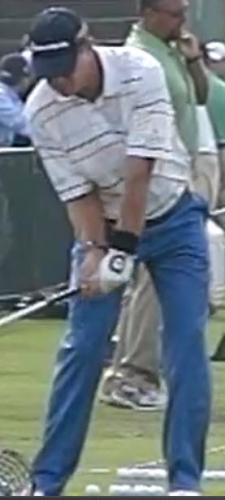


Scott Verplank
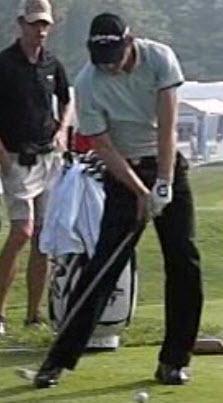
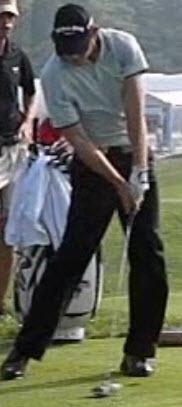
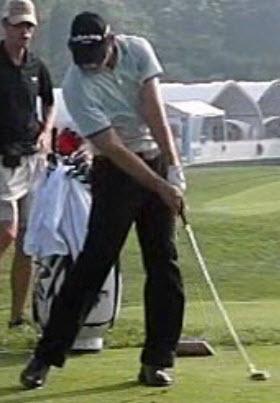
Aaron Baddeley
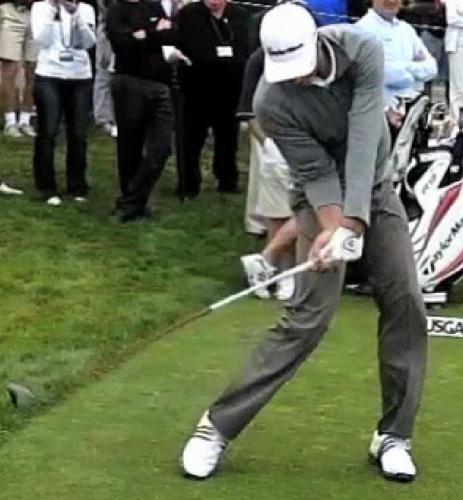
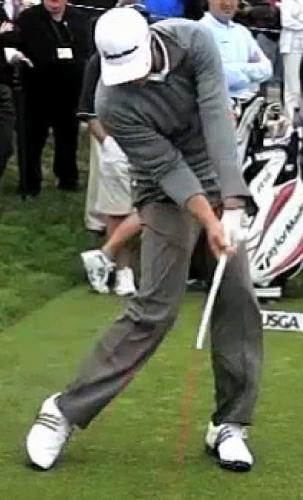
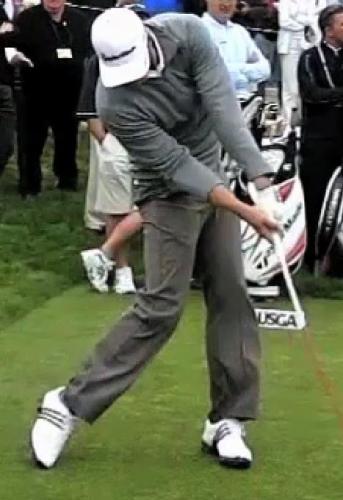
Dustin Johnson

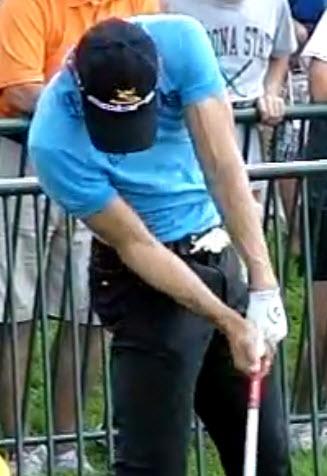
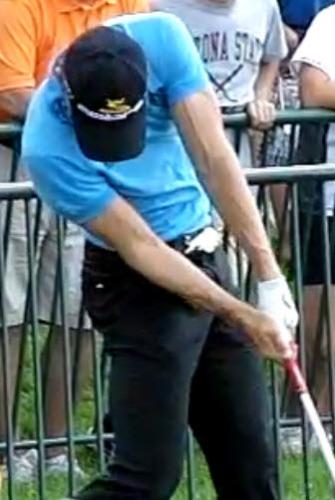
Camilo Villegas

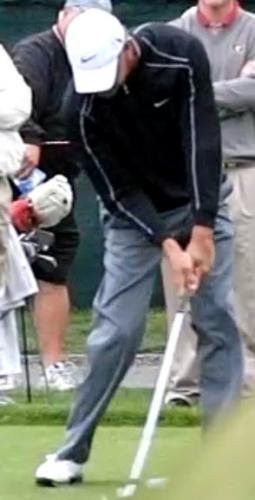
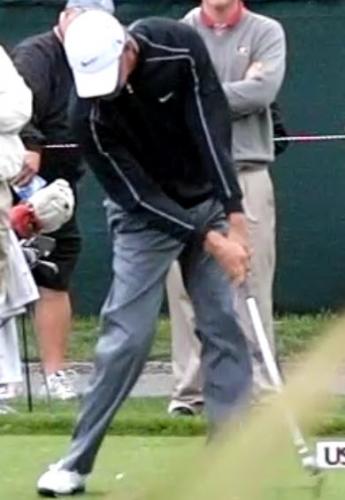
Lucas Glover
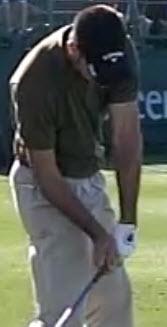

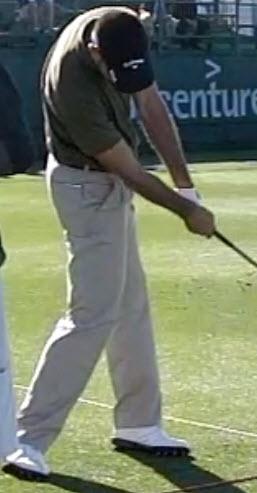
Alvaro Quiros
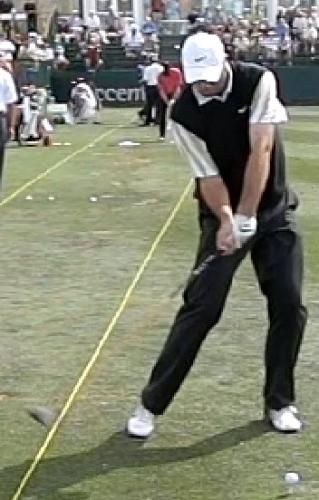
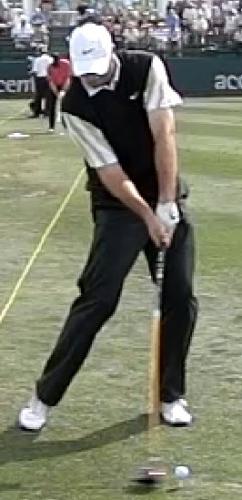
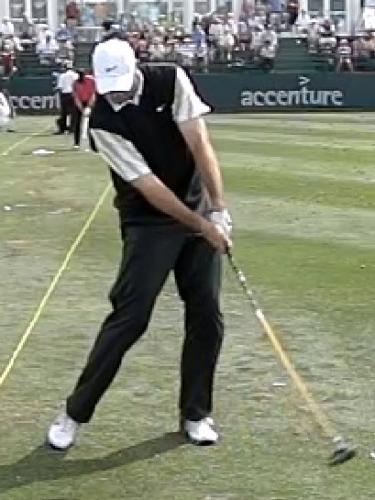
Stewart Cink
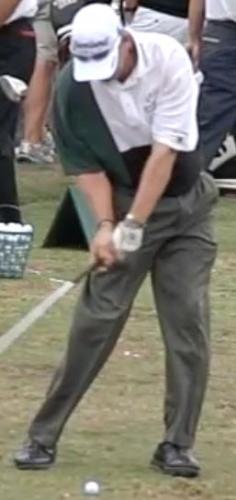
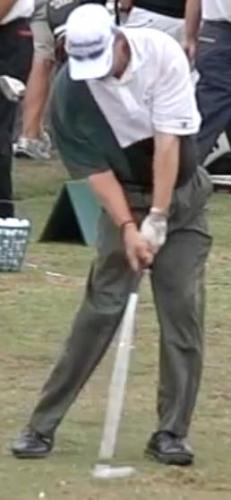
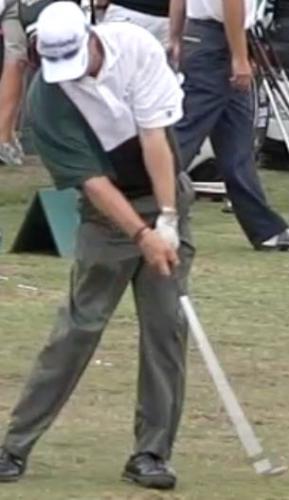
Woody Austin
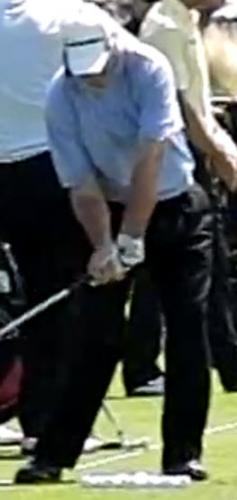
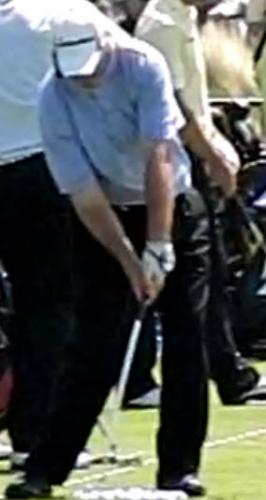

Paul Goydos – Looks good enough to shoot a 59!
Knife Edge Strikers using Drive/Hold pattern
Knife Edge Strikers use a cupped wrist to employ the Drive/Hold pattern. A strong grip typically yields a more closed clubface position and they square the clubface early just like other DH’ers and this allows them to drive/hold through impact with very little wrist rotation needed to hit it straight.
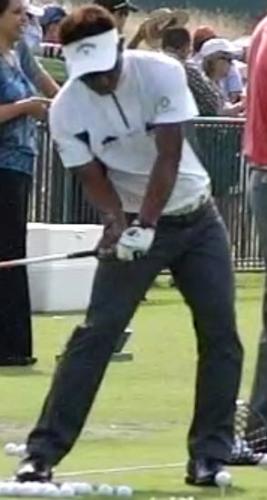
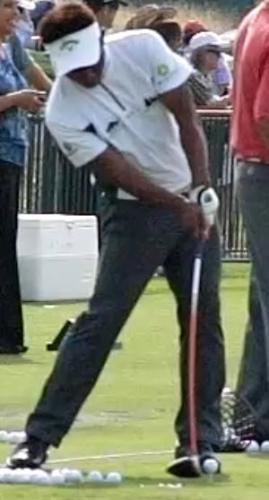
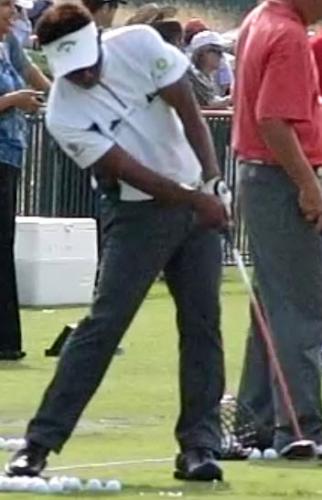
Thongchai Jaidee
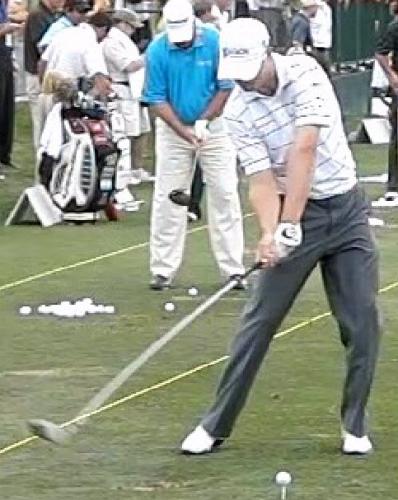
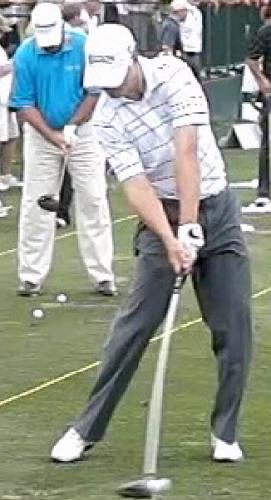
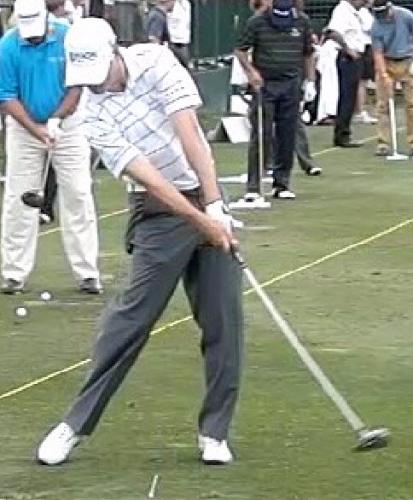
Zach Johnson

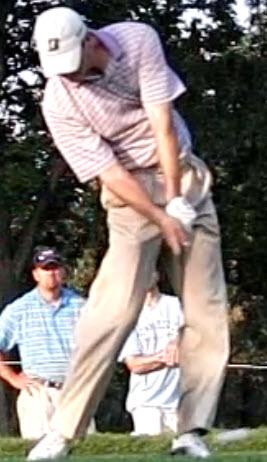
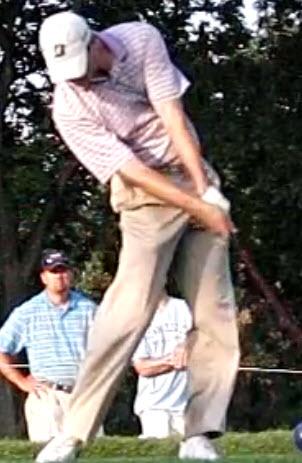
Matt Kuchar
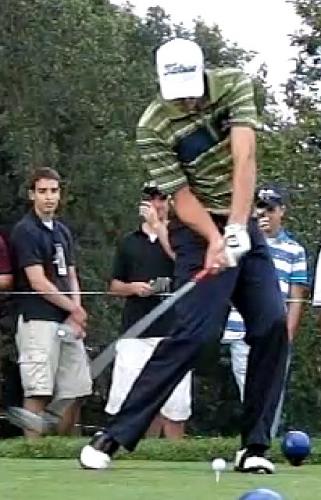
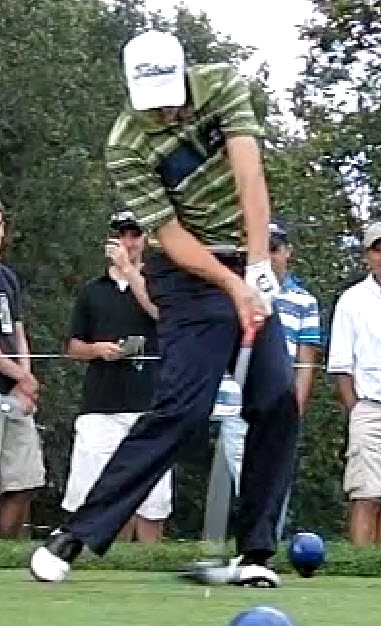
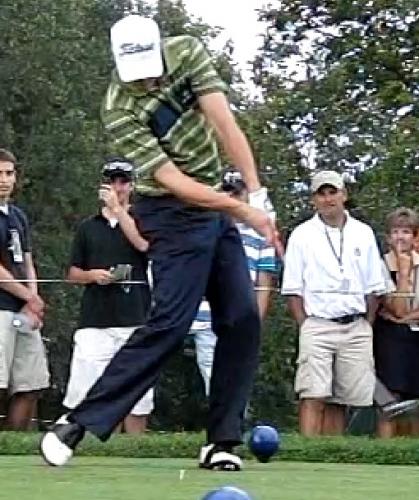
Nick Watney
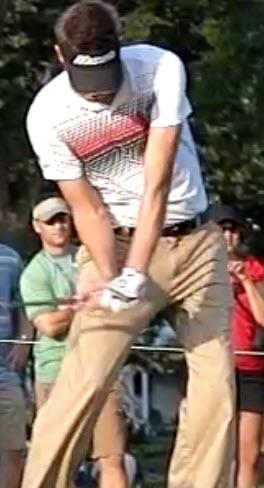
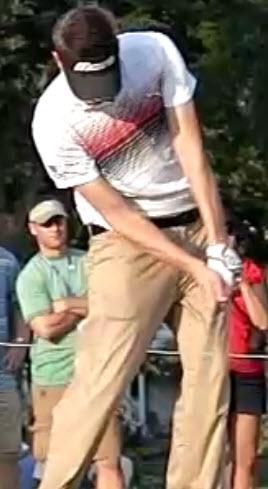
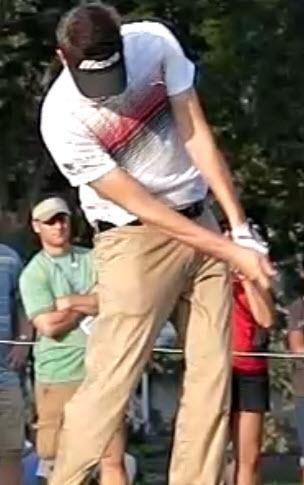
Jeff Overton
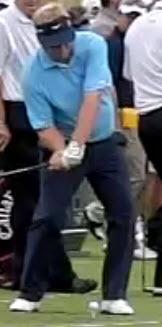
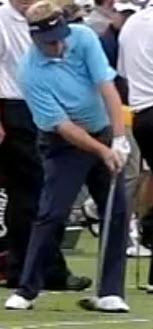
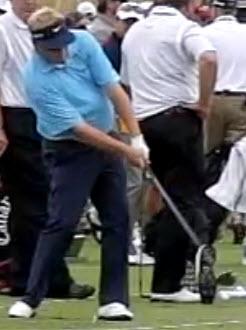
Carl Pettersen – He may have an over the top swing but check out his impact position!
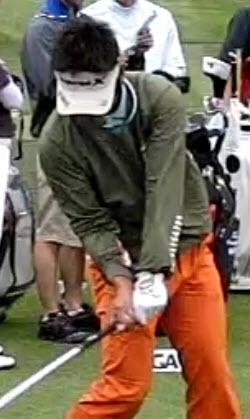
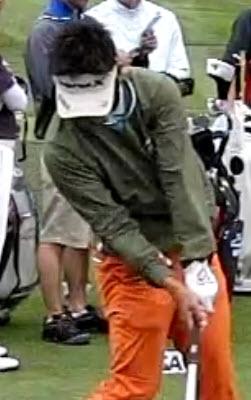
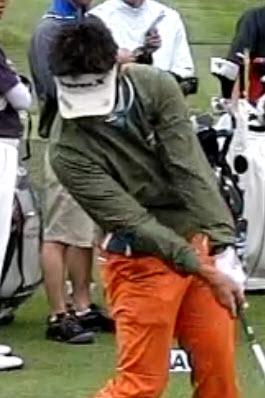
The last two here are two world long drive champions, Jamie Sadlowski and Dave Gourno. Both hit the ball far and relatively straight for their given driving distances. Both employ the knife edge striking technique.


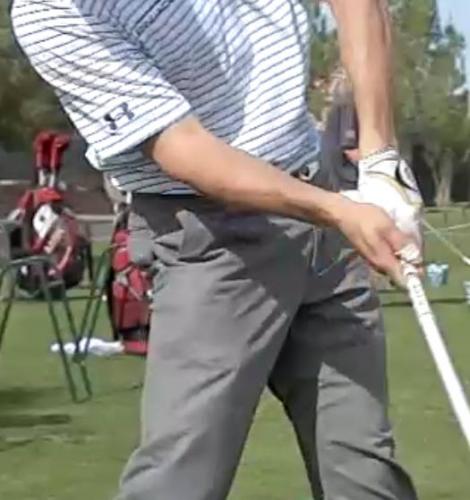
Jamie Sadlowski

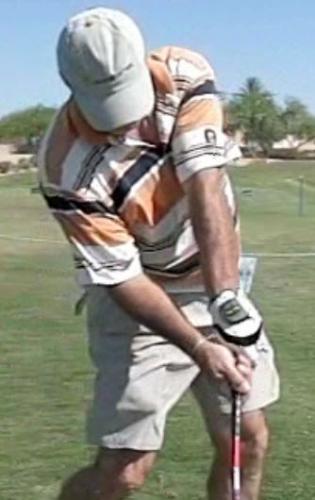
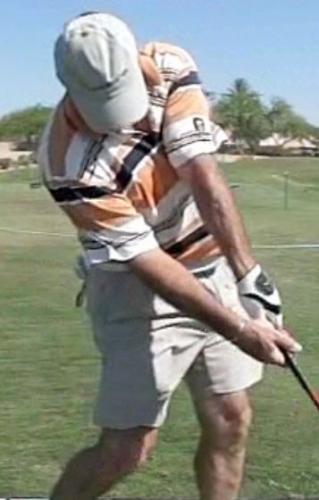
Dave Gourno
Flat DH’ers
Flat wrist DH’ers supinate their left wrist perhaps only half as much as the bowed DH’ers in the pre-impact phase. Since they don’t supinate much, their clubface gets squared early by releasing their lag earlier. Take notice of the especially good front views of Ryo Ishikawa, Rory McIlroy and Steve Stricker. There’s very little lag when the hands are at the right thigh.
Then, in the last few frames, they explode with their left wrist and forearm to keep the club from passing their left forearm or in other words to stop from flipping. This key feature of the flat DH’ers is what allows them to be powerful and accurate.

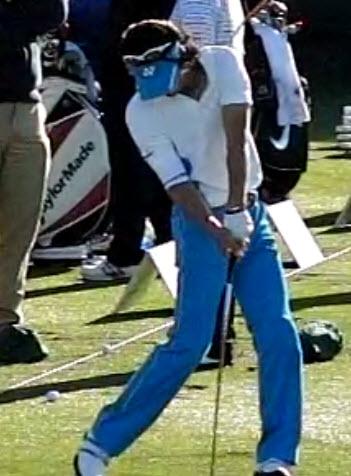
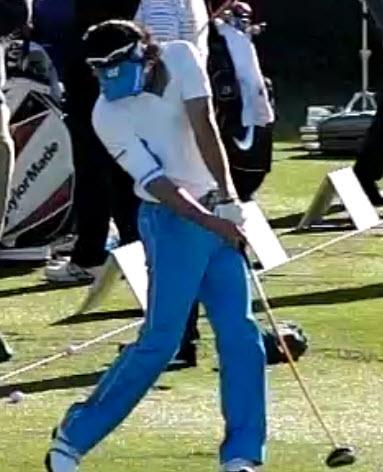
Ryo Ishikawa
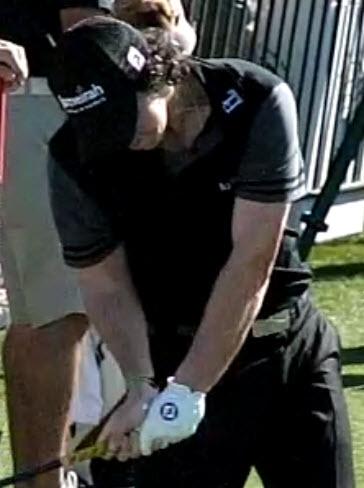
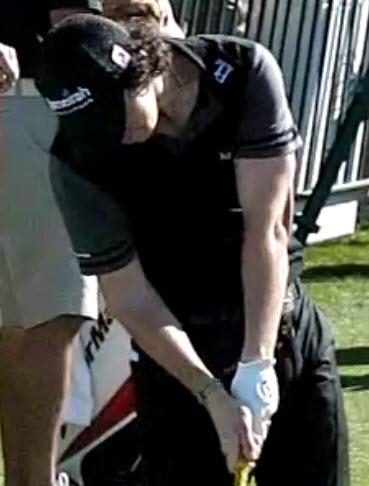

Rory McIlroy

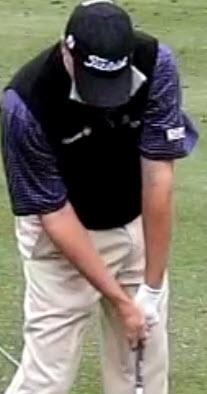
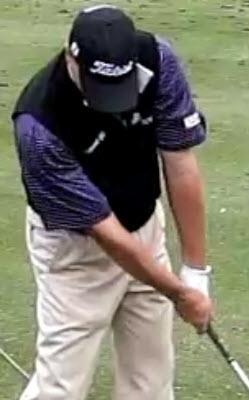
Steve Stricker
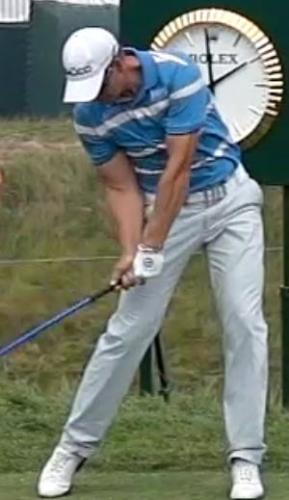
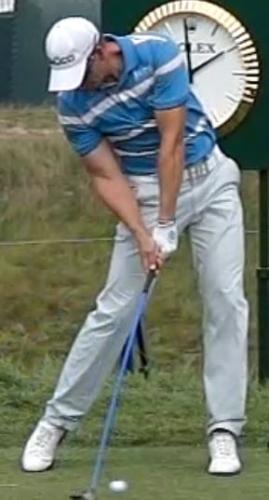
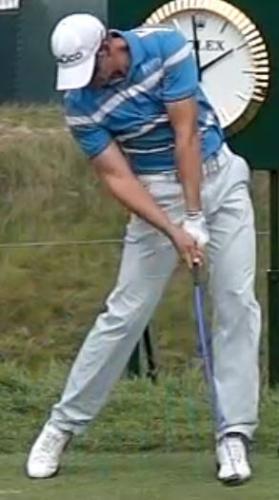
Henrik Stenson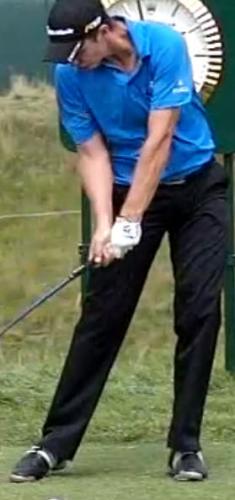
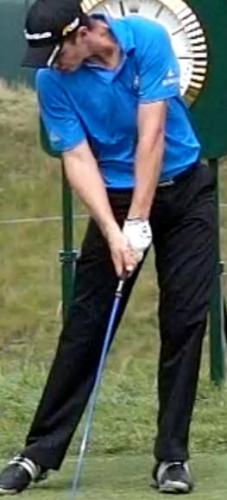
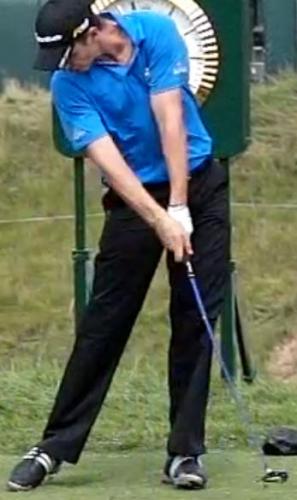
Justin Rose
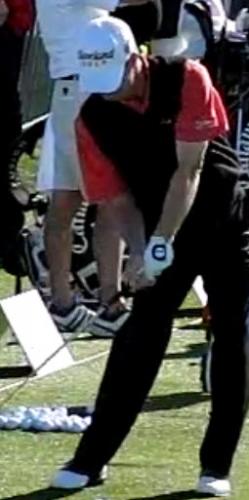
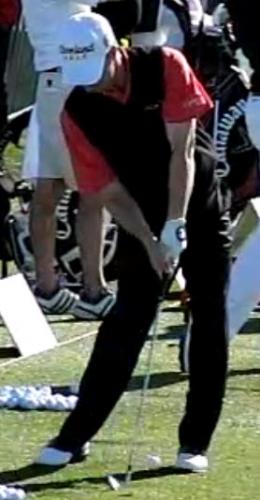
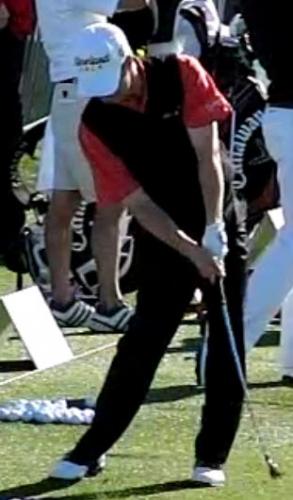
David Toms
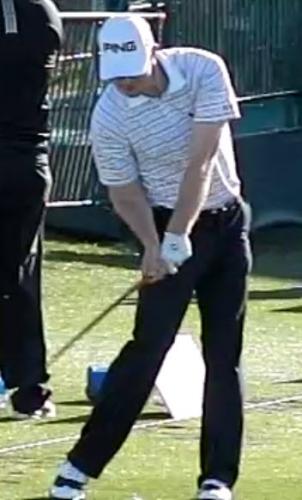

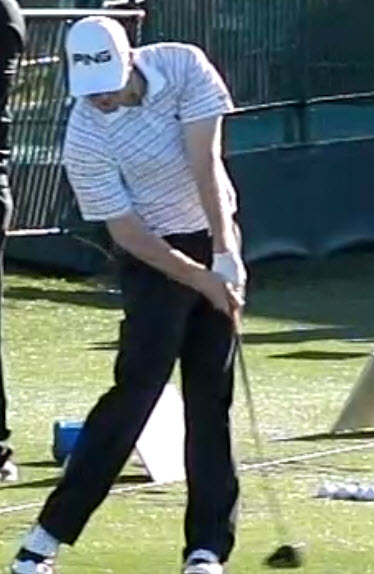
Hunter Mahan
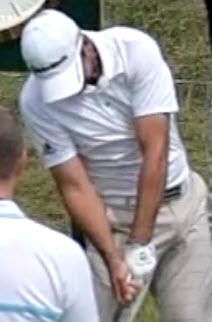
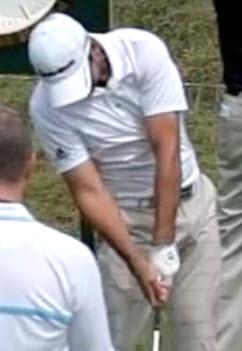
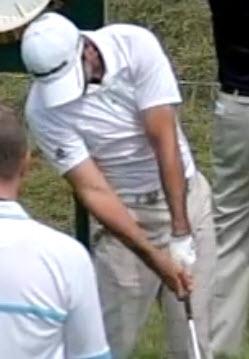
Jason Day
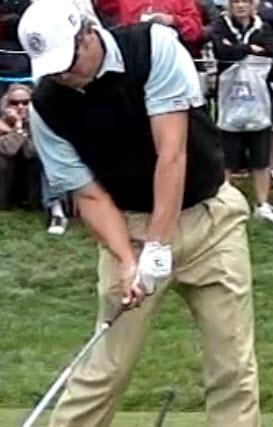
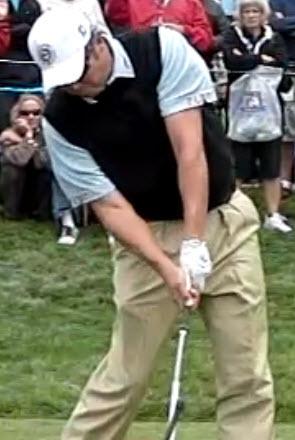
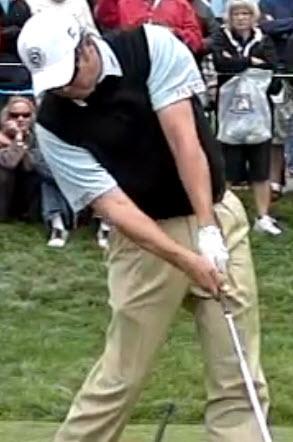
Bo Van Pelt
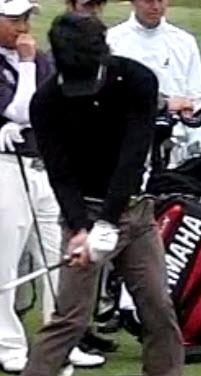
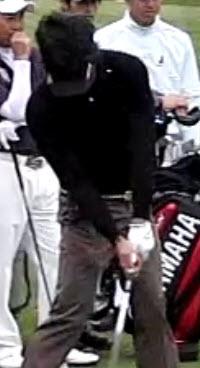
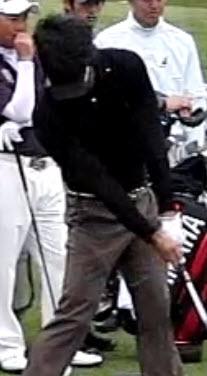
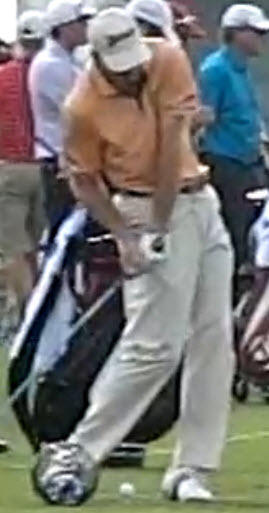

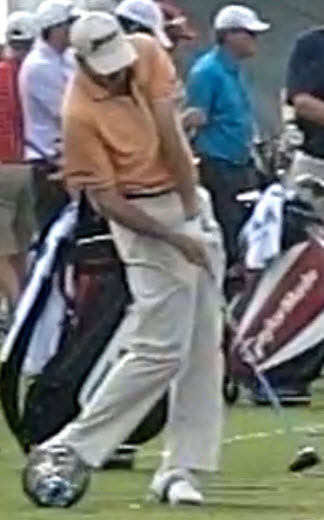
Jim Furyk
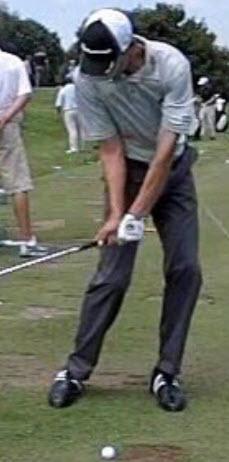
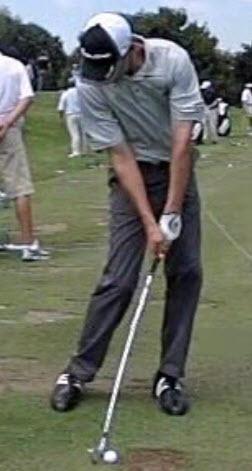
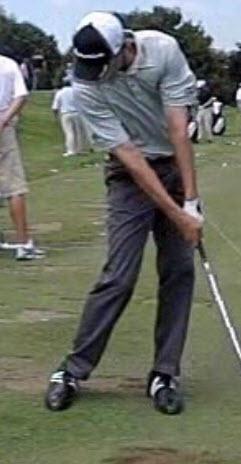
Sean O’Hair
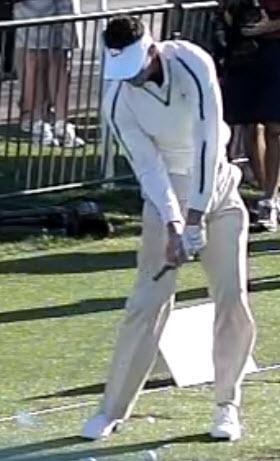
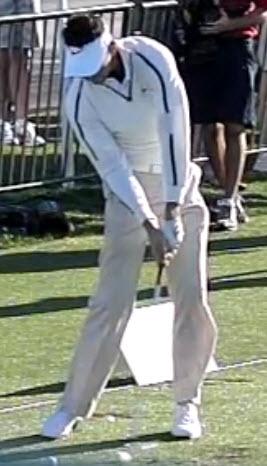
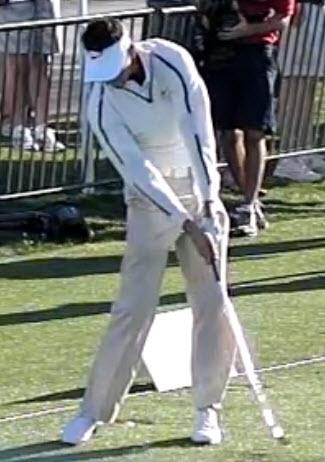
Charl Schwartzel

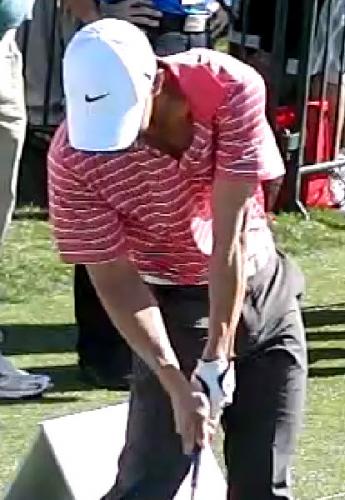
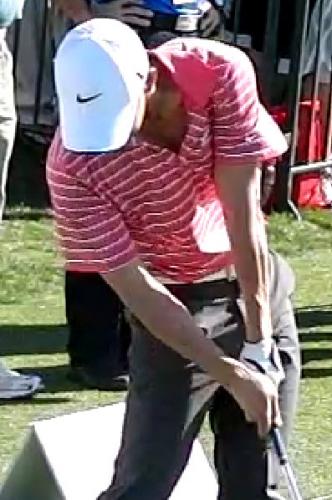
Anthony Kim
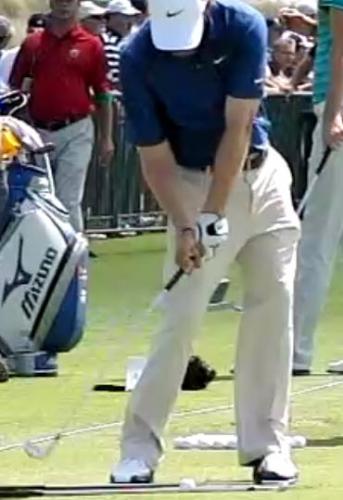
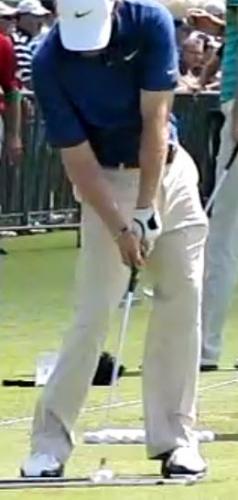
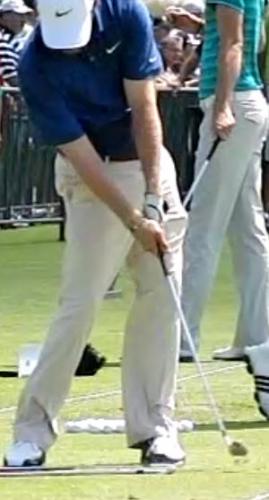
Justin Leonard


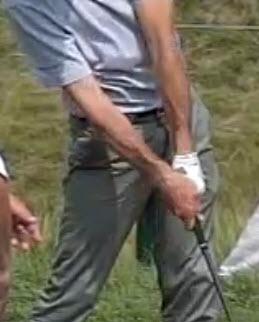
Geoff Ogilvy
Rollers
Rollers can be in similar positions at impact as the DH’ers. However, the movement pattern here is to roll the left forearm, hands and wrist through the impact zone due to their wrist position or clubface angle being a little more open than at the same location with DH’ers. Consequently, Rollers also have their right hand rolling over their left quicker as well. Clearly, this means the clubface gets closed much faster than if driving and holding the hands/wrists. Tiger 2010 is rolling his arms even faster than in 2009.
Rollers need to keep their rhythm and tempo fairly constant so their timing does not become a problem.
Side note: Rollers typically have their left arms “connected” to their chest and tend to fold their left arm earlier than DH’ers. DH’ers have their left arm moving away from their chest prior to impact and more down the target line in an effort to stabilize contact.
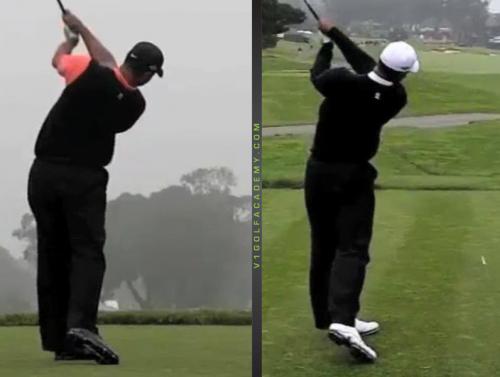
Comparing Tiger 2008 on the left with Tiger 2010, you can see the difference on his follow through. In 2008, his left elbow is higher, less folded and the left wrist is cupped vs. 2010, his left arm is folded down more and his left wrist is less cupped and more rolled.
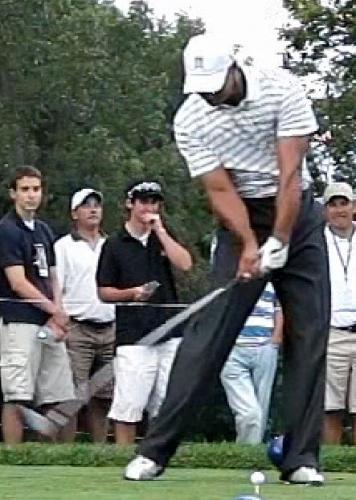

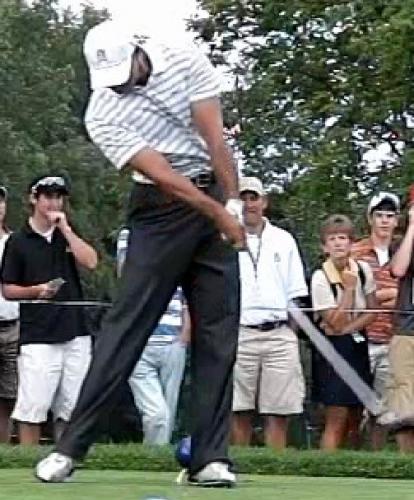
Tiger Woods 2009
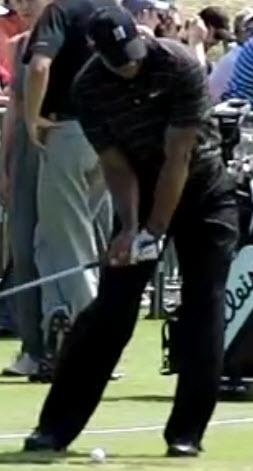
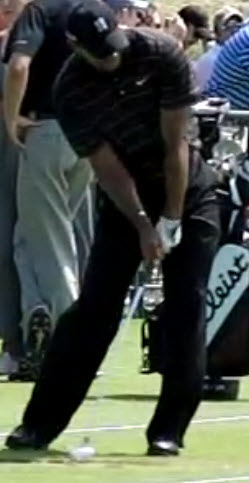
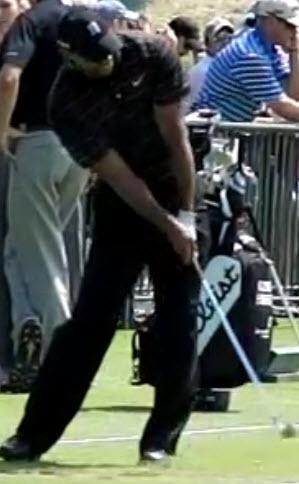
Tiger Woods 2010
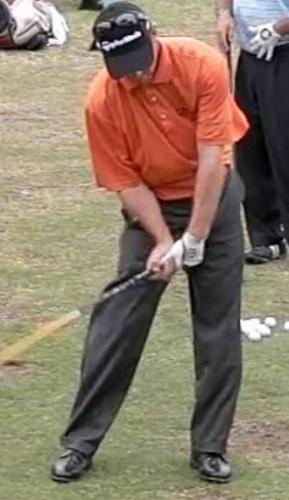
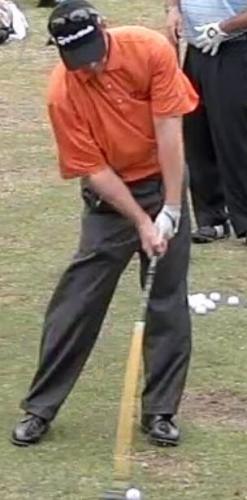

Rod Pampling
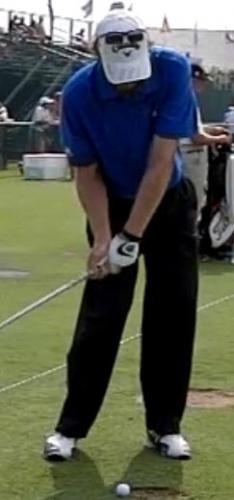
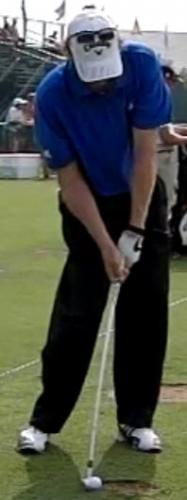
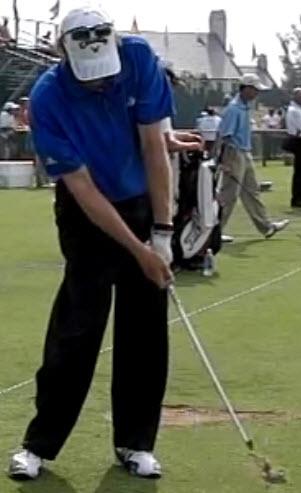
Tim Petrovic
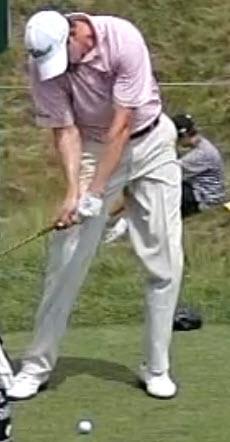
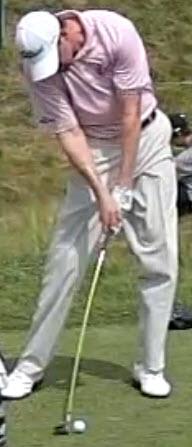
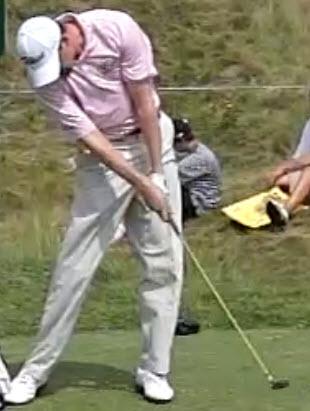
DJ Trahan
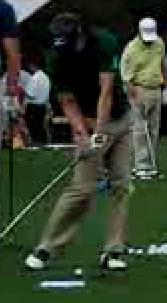
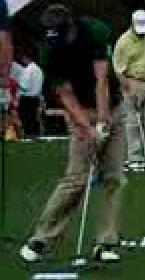
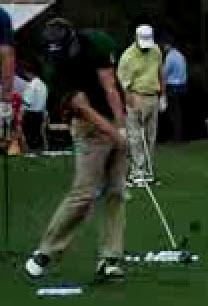
Luke Donald
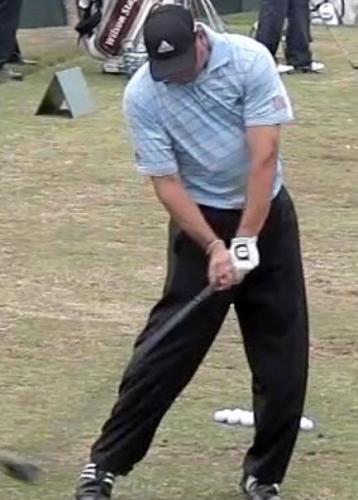
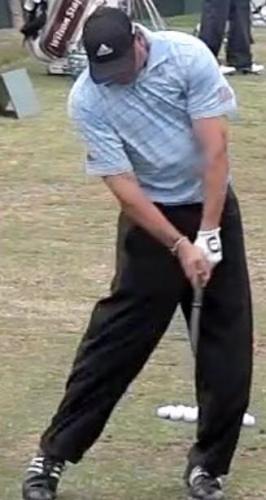
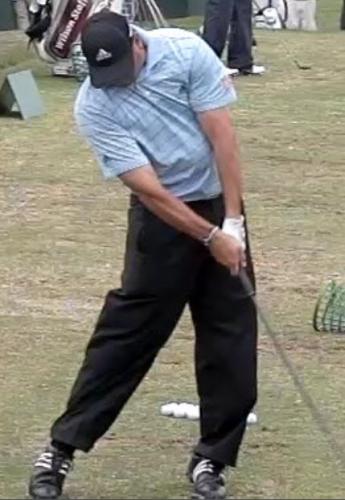 |
|
Pat Perez
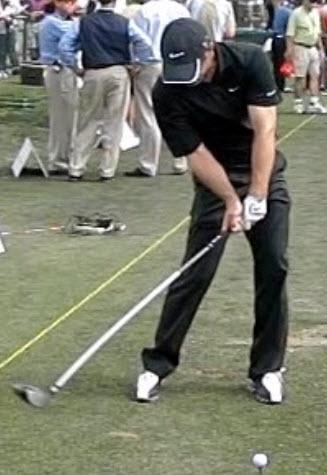
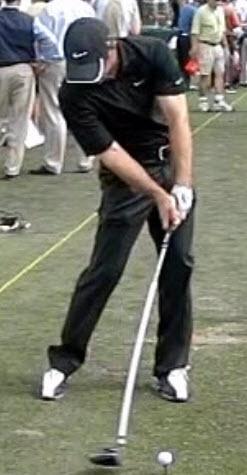
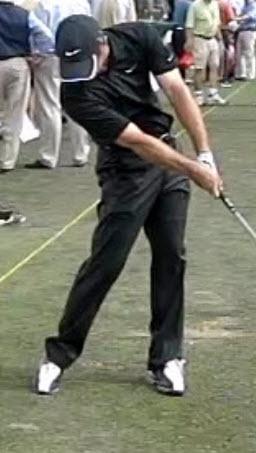
Trevor Immelman
Bowed yet still rolling.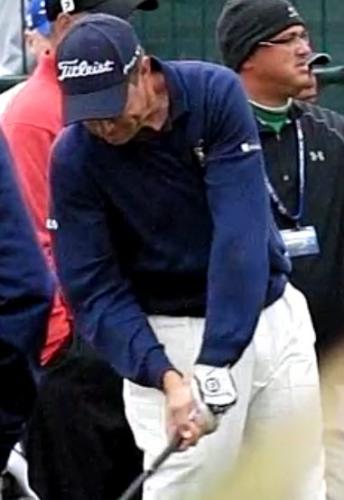
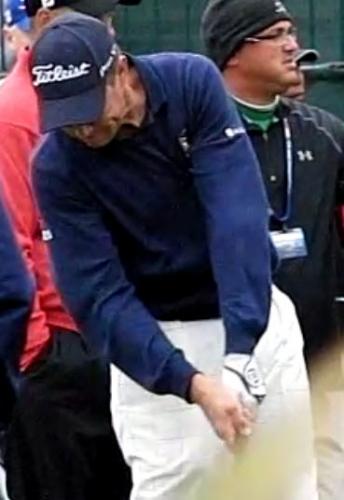
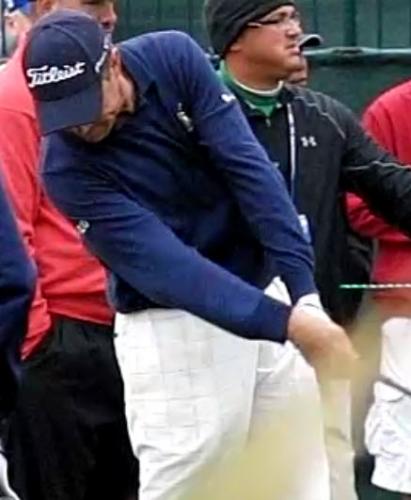
Davis Love III
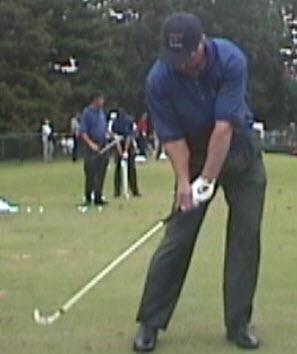
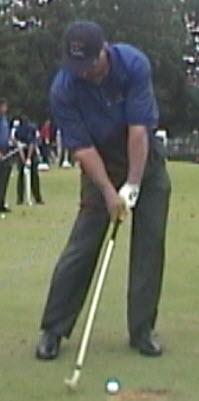
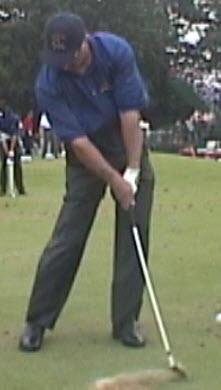
Tiger O’Meara
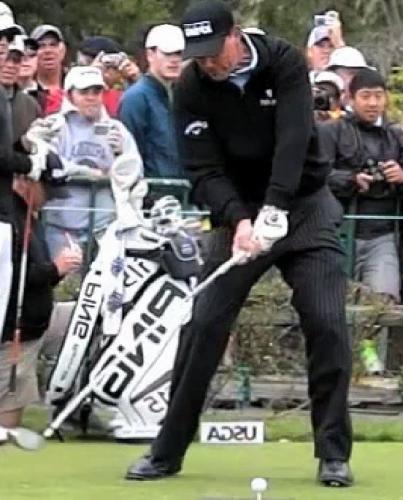
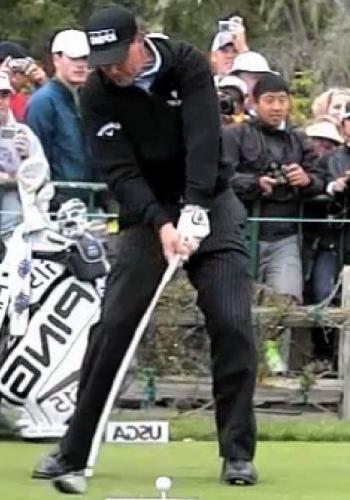
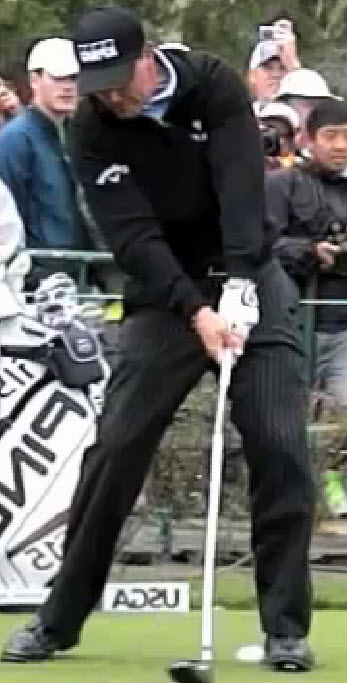
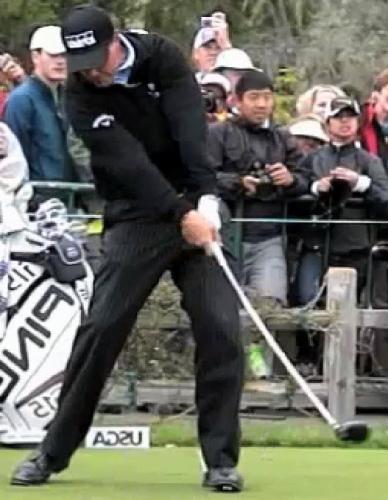
Phil Mickelson
Switched Phil to right handed so we can compare better. Notice at one frame prior to contact Phil has the clubface open by a large amount and must close it in that one frame. This forces him to roll his clubface quickly or hit it the big fade.
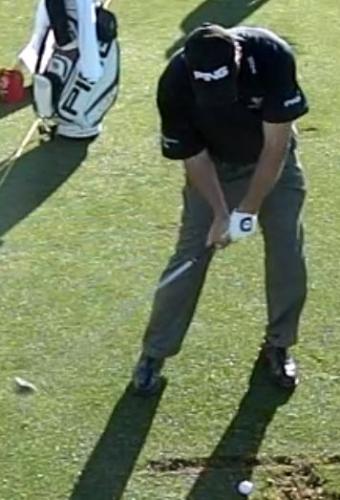
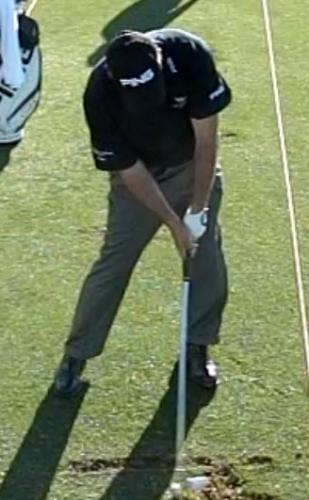
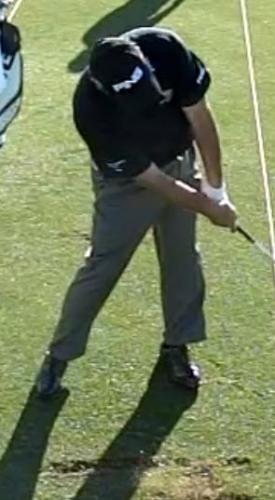
Angel Cabrera
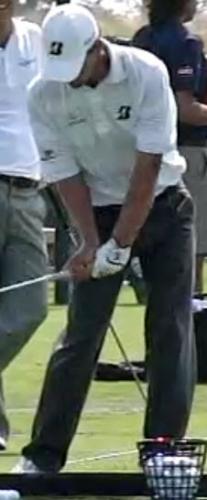
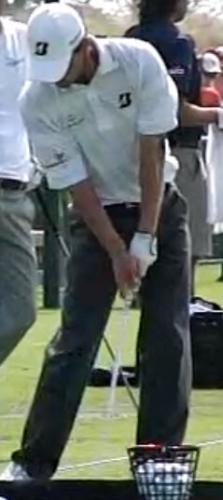
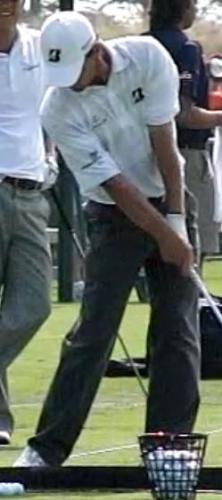
Charles Howell III

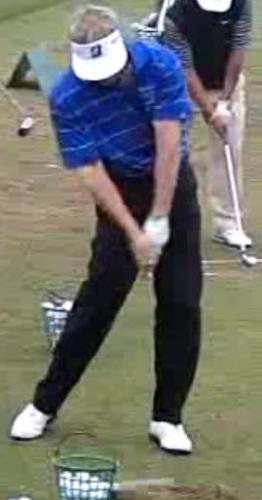
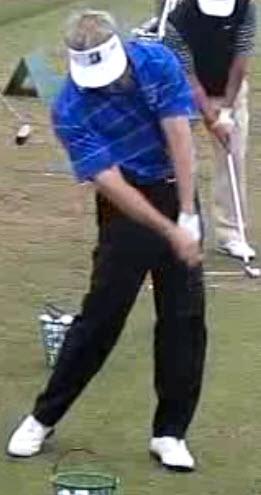
Stuart Appleby
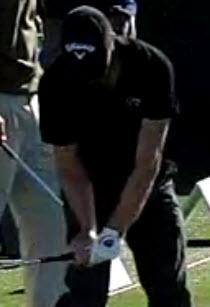

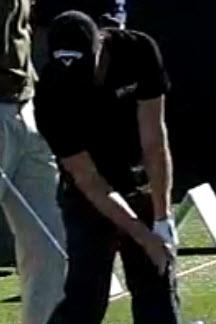
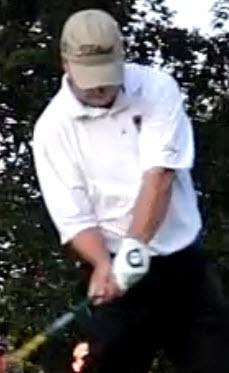
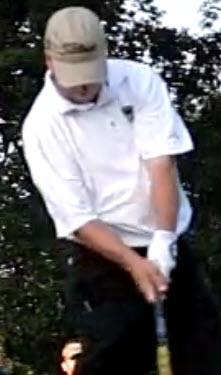
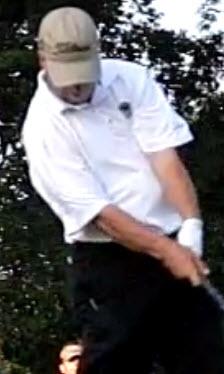
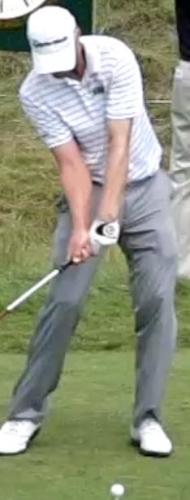
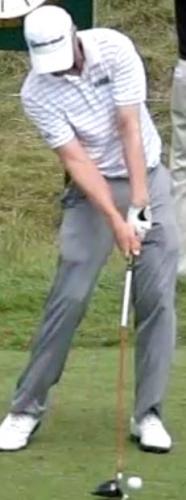
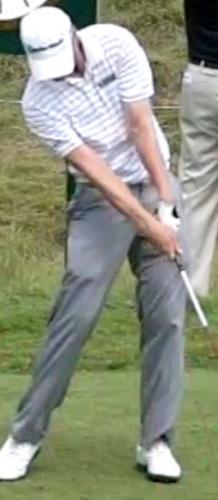
Vaughn Taylor
Pro Flipper
A Pro flip release can take one of two forms: one is the PGA tour flipper that allows the club to pass the left forearm but keeps the clubface square albeit with added loft; two is an underflip method where impact position is pretty good but the left wrist cups while the right wrist works under as impact is occurring.
Flippers can tend to hit the ball fat and compensate by moving the upper body forward or toward the target. This is why one of David Leadbetter’s concepts is to have the chest “covering” the ball at impact as you can see Lee Westwood adeptly showing below.
Another anti-fat compensation move for flippers is that they need to extend their right arms past impact and follow with their right shoulder.
Also, in order to be a good flipper, you must keep your body quiet. Aggressive hip and leg movements do not mesh well with the flip swing as precise adjustments must be made to flip it straight. This, in addition to the built-in added loft and spin, reduces maximum distance. However, this is an accuracy-only swing and several big-name flippers lost their swing when seeking to improve their driving distances. Ian Baker-Finch, Grant Waite comes to mind.
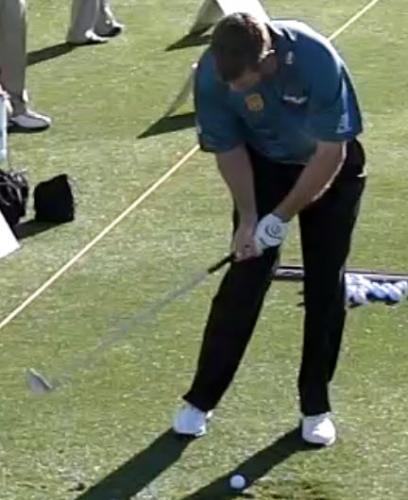
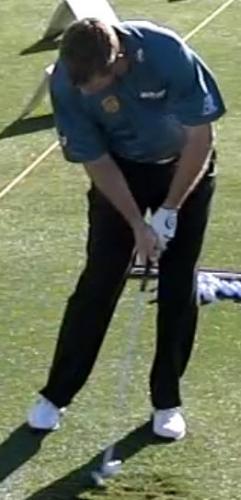
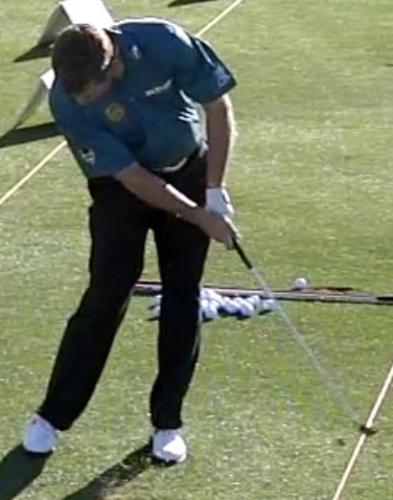
Lee Westwood
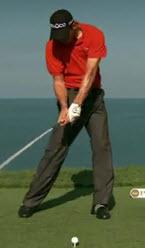
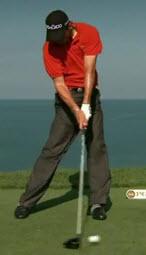
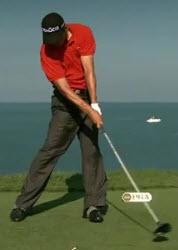
Martin Kaymer

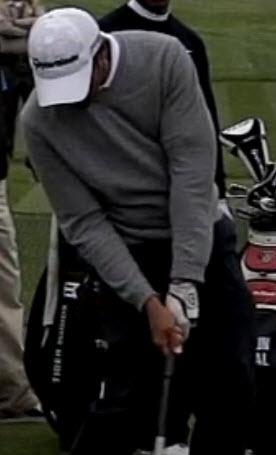
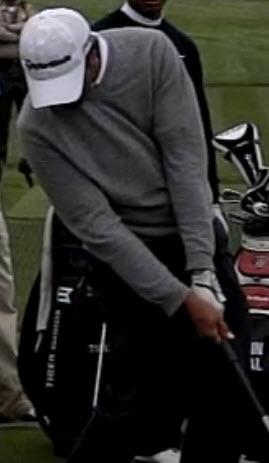
Arjun Atwal
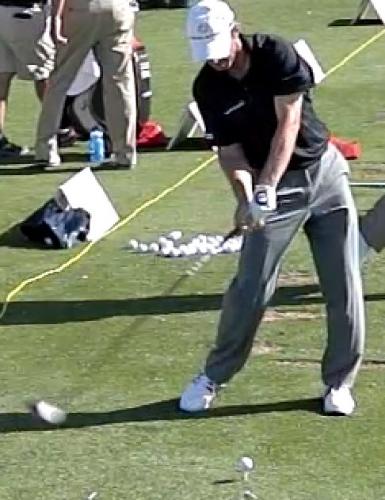

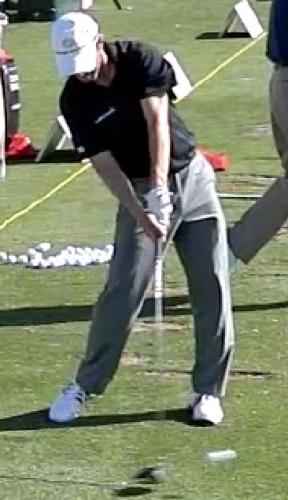
Mike Weir
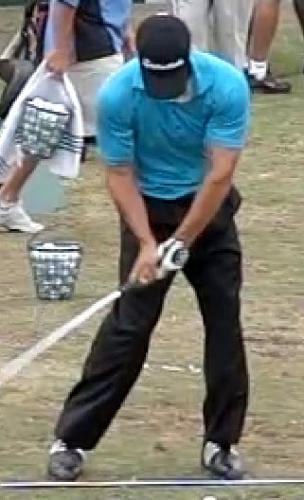
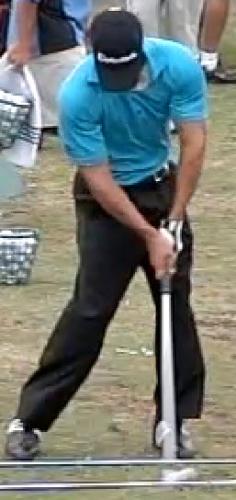

Casey Wittenberg – Could this be the reason he hasn’t had the career everyone had anticipated?
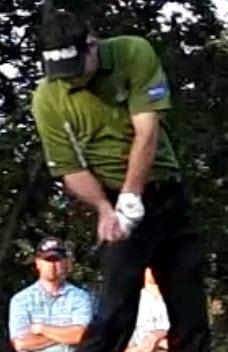
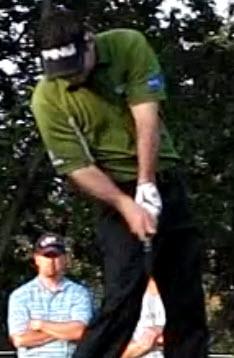
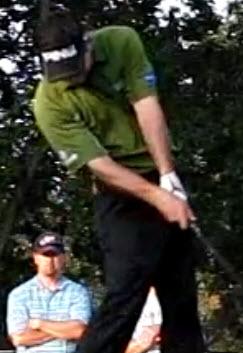
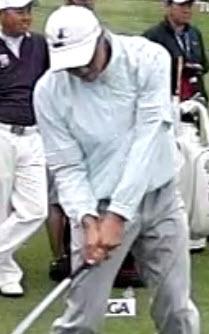
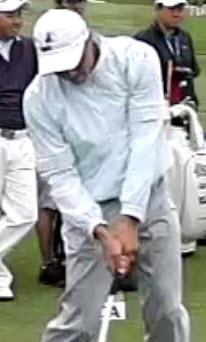
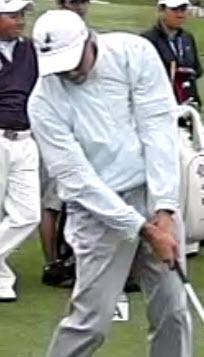
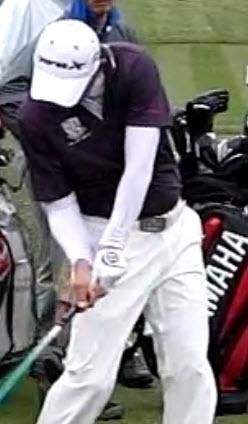
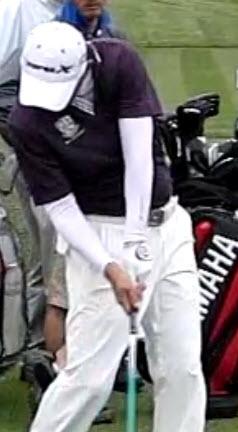
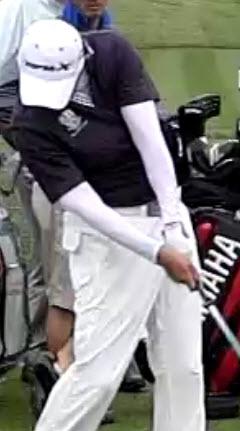
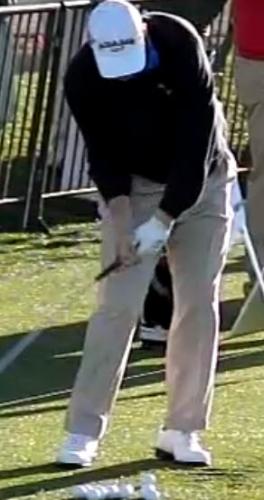


Chad Campbell

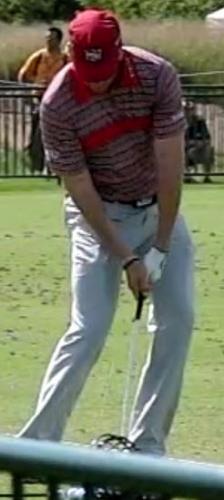

Ricky Barnes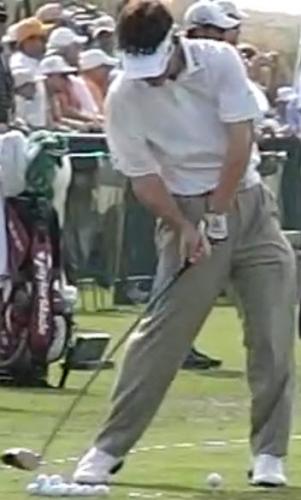
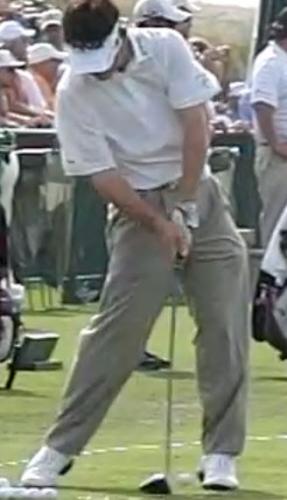
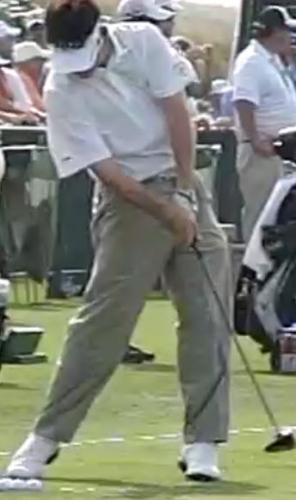
Louis Oosthuizen – good enough to win a major. On TV it looks great. In 300 fps, it’s not quite the same.
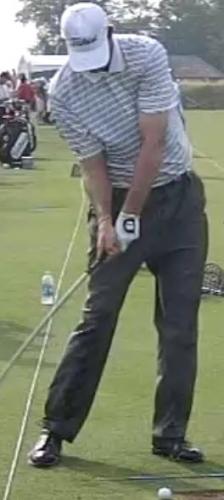
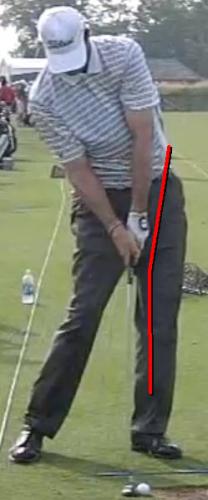
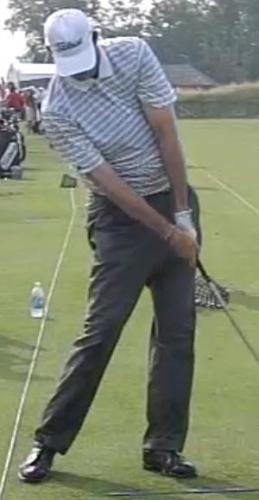
Bruce Smith
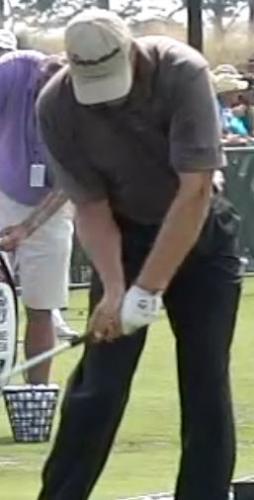
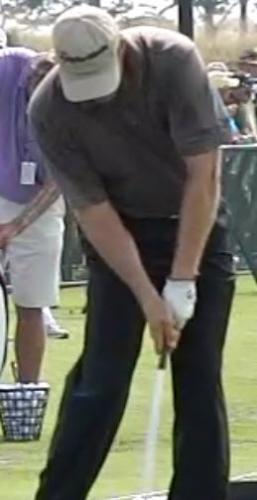
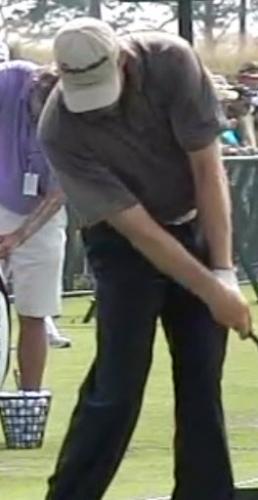
Retief Goosen



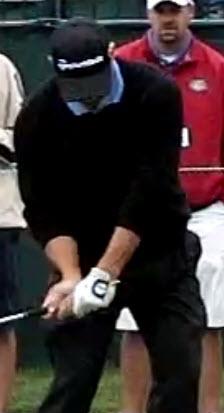
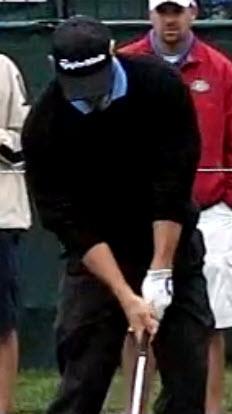
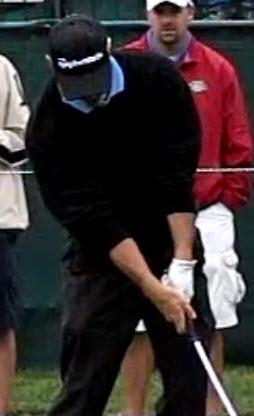
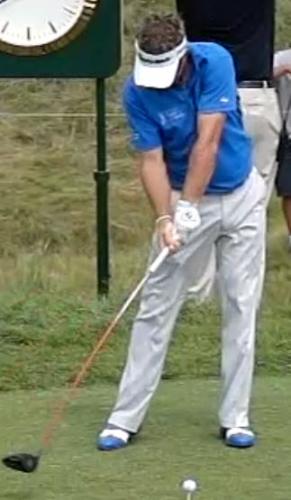

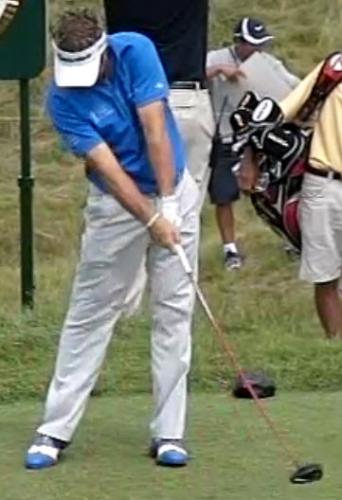
Brian Gay
Underflip w/Good Impact Position
This is a subcategory of the flippers. Some players appear to have a great impact position, yet relax their hands/wrists into a flipped/cupped post-impact position. This allows the club to pass their left forearms in comparison to the DH’ers. By doing so, this is going to add loft and backspin to the shot. The flip occurs ever so slightly and slowly as impact occurs. This adds to one’s loft and spin while reducing distance slightly though not so much as the pure flipper.
The traits to look for are the right hand moving under post impact with the left wrist cupping slightly. Yet they do have a decent impact position. What’s also missing is any ulnar deviation.
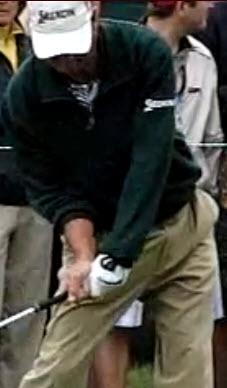
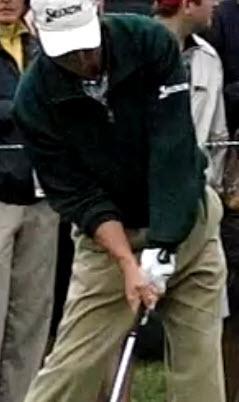
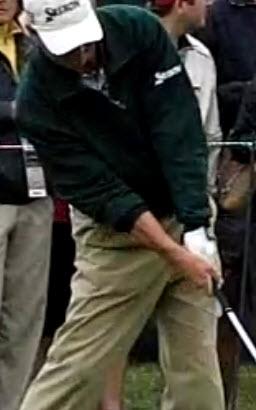
Harrison Frazer
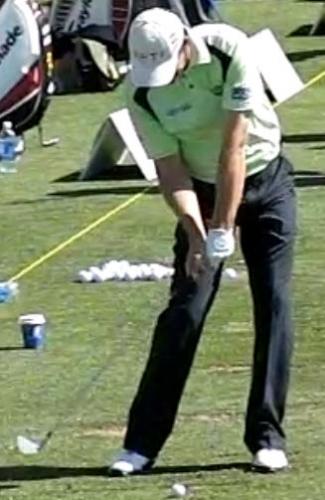
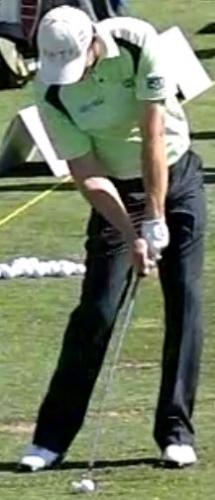

Padraig Harrington
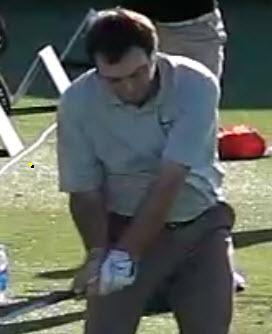
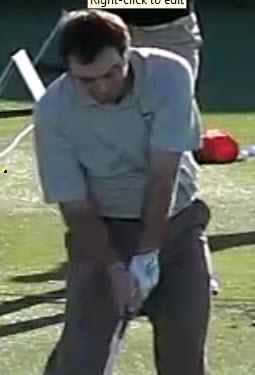
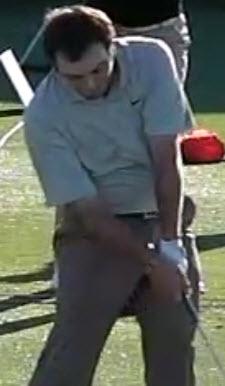
Fernando Molinari
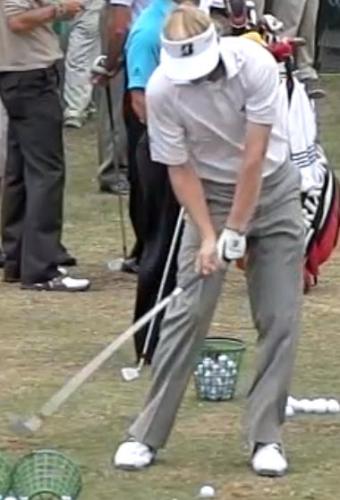
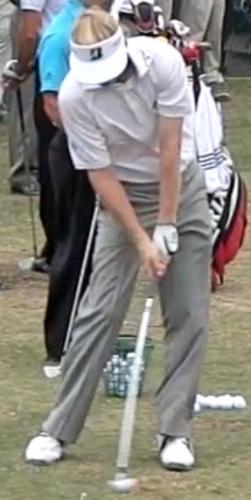
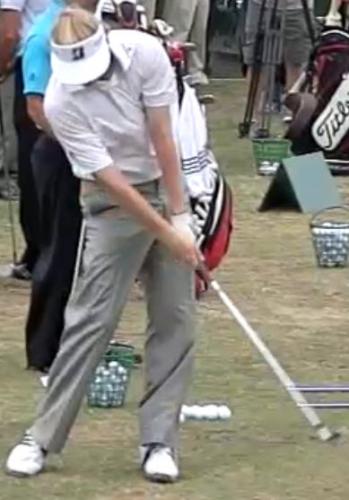
Brandt Snedeker
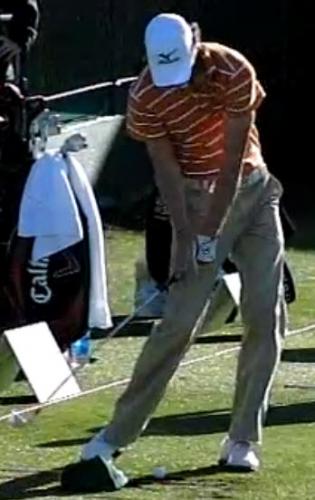
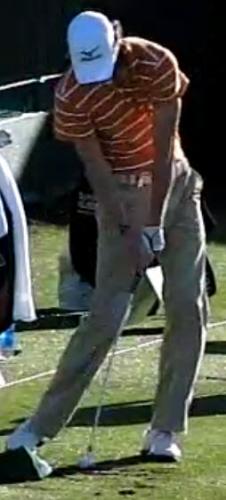
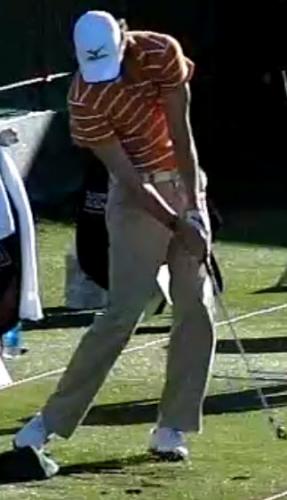
Chris Wood

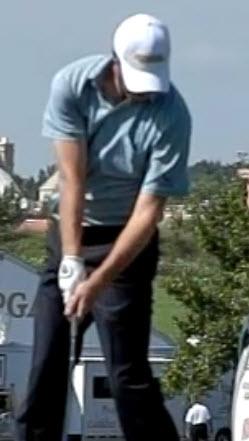
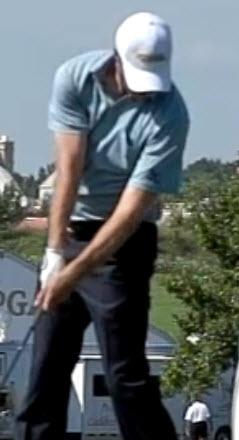

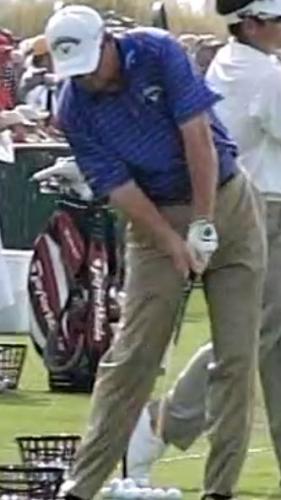
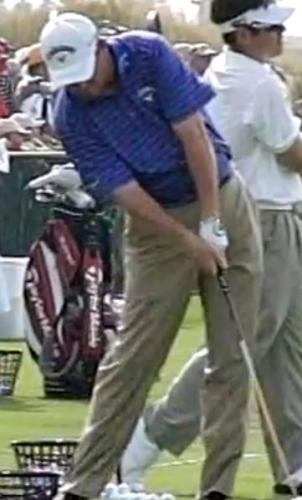
Shaun Micheel
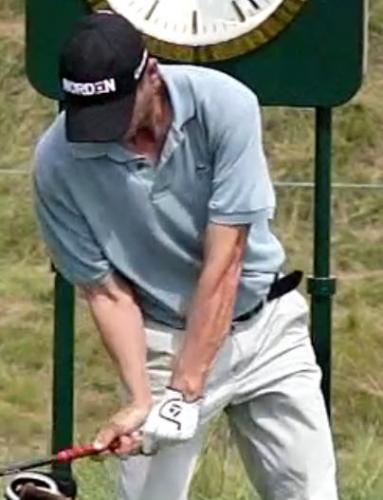

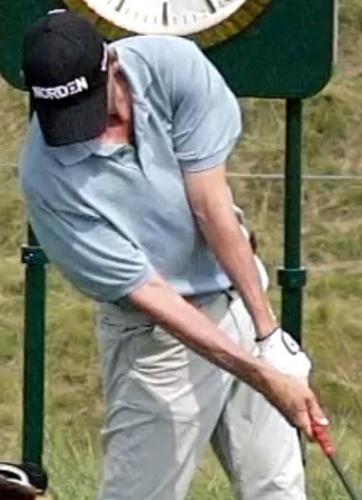
Anders Hansen
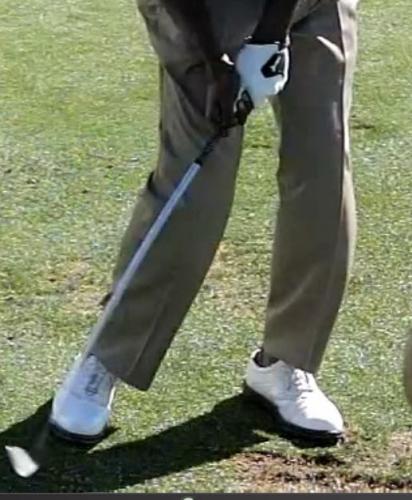
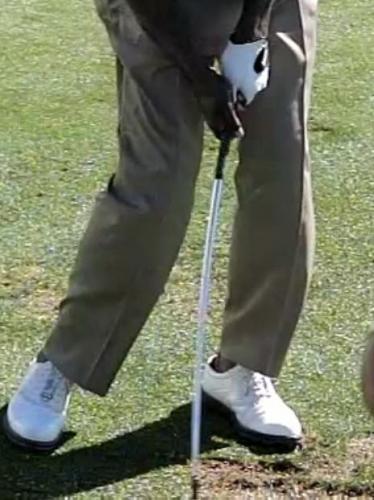
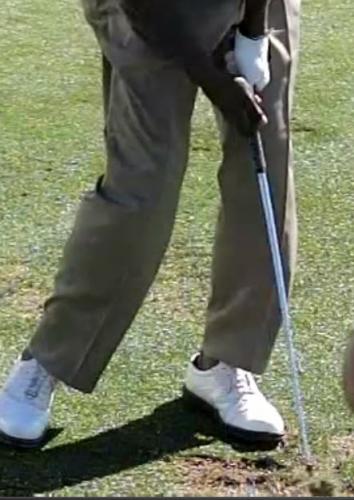
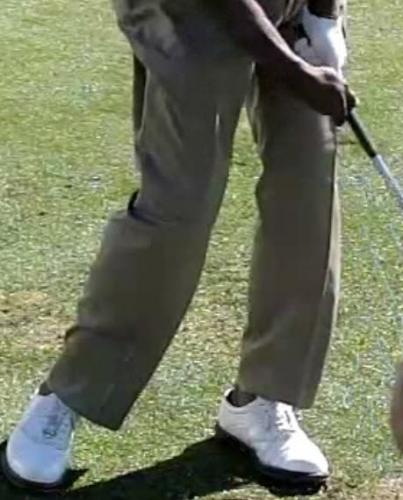
Vijay Singh
Amateur Flip = flip/roller or flip/roller + chicken winging
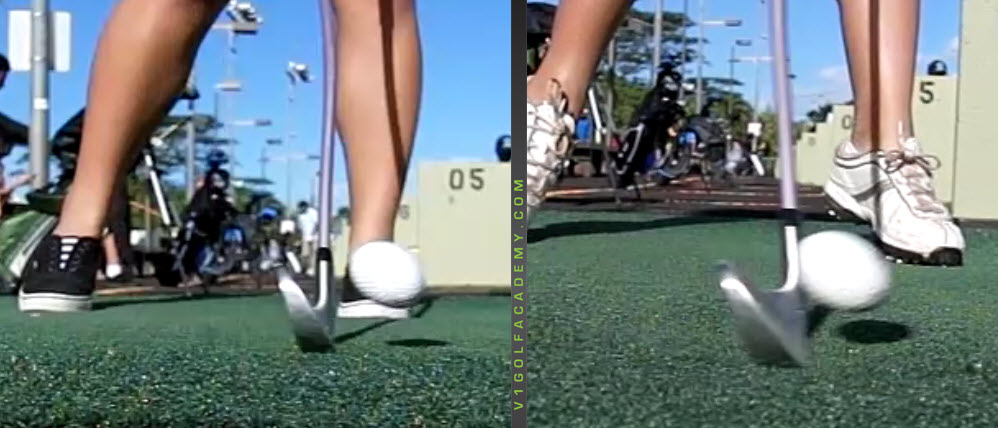
Can you see the differences in loft as well as clubface position due to DH strike vs. a flip? The animation shows that the flipper shot was hit at least an inch fat as well.
However, there are two types of flips used on the PGA tour. I shall cover this more in depth later in the article. But simply put, the distinction between the two relate to when the flip occurs; earlier or later. In both cases, as the left wrist cups, there is little or no supination occurring in conjunction with the flip. This keeps the clubface square although it does add loft and therefore reduces distance.


The amateur flip is a pattern that is not used on tour. It is a flip/roll release. Flip/rollers are using some supination while they are allowing the left wrist to cup. This is a dangerous pattern since pull hooks and hooks are typically the result of this pattern. To avoid hooking, a golfer with this pattern will revert to an underflip thereby creating the military golf pattern of errors. Left, right, left, right, left……..
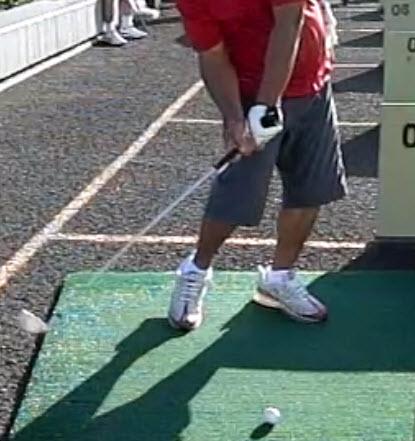
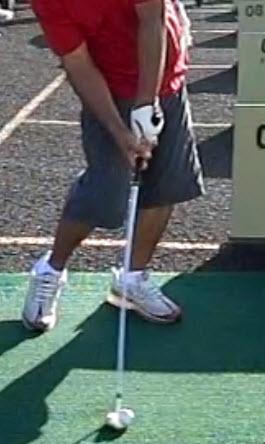
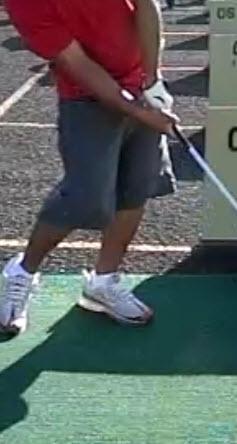
Besides the flip/roll release, amateurs tend to make another very common error. They pull their left elbow up (chicken winging it) along with the cupping of the left wrist and this plus shoulder rotation equals a slice across the ball that produces guess what? A slice!
Also, the bottom of the swing arc will usually be behind the ball since the arms are at their most extended at impact vs post-impact for the pros.
Commonalities
Bottom of the arc in the right place
All players find a way to have the bottom of the swing arc be well in front of the ball. Most popular is to allow the left arm to straighten at and after impact. 76 of 95 players studied showed some left arm bend prior to impact and most show straightening through impact. This is the primary mechanism that allows for consistent clean striking of the ball vs. the many fat shots that amateurs have.
The exceptions to this general trend are the Leadbetter types that use right arm straightening to do this. See Lee Westwood and Retief Goosen pictures. Leadbetter flippers also use little or no lateral bend and may even lunge their upper body toward the target to remove the possibility of fat shots.
Clubface square early
All players try to have the clubface closer to square 12”-18” prior to contact to reduce the amount of last millisecond clubface closing that can cause timing problems. They can do this by doing one of the following:
• Bowing the wrist early like Pampling or Tiger
• Reducing lag. Many tour pros use this method judging by the pictures.
• Reducing lateral bend.
*Exceptions are some of the rollers like Mickelson that have both lag and cupped wrist.
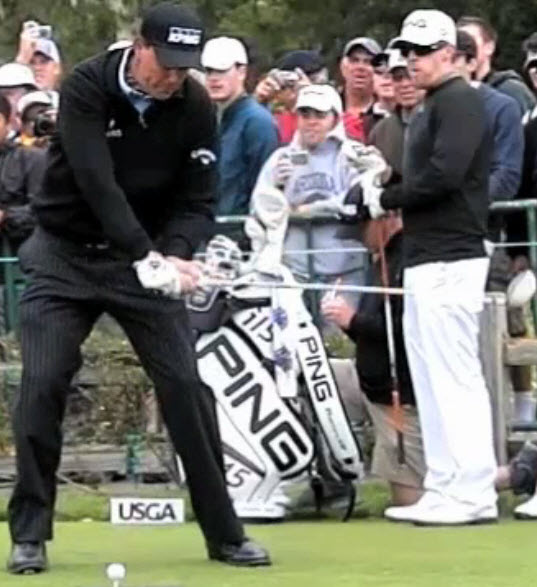
This keeps his clubface open till just before impact and he needs a fast roll of his wrists or he’ll leave it open.
Clubface stabilization
All tour players are using some method of stabilizing the clubface. Whether by drive/holding or bowing while rolling (this slows the rate of rotation) or flipping under to keep the face square, the tour pros get the job done.
Not everyone retains as much lag as we think
Players retaining a lot of lag are in the minority. With just a handful even approaching their physical limit for lag, this seems to be a mirage in some people’s minds vs. a real important movement or position for PGA tour golf.
Left arm to chest connection is not universally used
Most of the drive/holders separate their arms from their chest just prior to impact. Those with the largest amount of bowing of the left wrist are doing that. Those with connected arm and chest tend to have more cupped wrist or flat wrist at impact.
Some Questions
By putting the release moves of the pros under a microscope for public to see, this answers many questions but also leaves several questions about instruction up in the air.
Many golfers have been taught to do an “L” to “L” drill. This just teaches a flip release with the bottom of the arc too close to where the ball is or worse yet a few inches behind. Is this what we want to do?
Should we forget about lag and worry more about driving and holding through impact like Rory or Stricker?
Is there such a thing as an effortless PGA tour golf swing??? Impossible. Each and every one of these swing styles requires tremendous energy to be expended through impact to stabilize the clubface and put the bottom of the swing in front the ball. Even what you might think of as the least effort release style, the flip, requires the right arm and shoulder to drive through aggressively. If not, the flip can quickly turn into the flip/roller/chicken winger with huge timing issues that can’t be resolved consistently.
Everyone’s selling a system these days. However, one of the problems with learning a system is that the language isn’t always accurate and you’re trusting someone’s interpretations of what is going on in the golf swing vs. seeing exactly what’s going on in the golf swing. Is there a difference?
Thus, maybe you can get caught up in words and interpretations that might have you running in circles. So maybe what you have to do is study what the best players in the world are doing or from that system are doing and copy that? I think most people can sort of copy something if they’ve seen it in slow motion better than relying on interpretations of what someone is doing.
Perhaps the best way for golfers to use the information in this article would be for them to find a style that is closest to what they currently do. Once you find a pro that swings most similar to you, then copy the essentials of what they do. Not all of us can swing like Tiger. And possibly fixing your flip isn’t in the cards, but you can certainly improve towards a pro flip.
Lastly, in this age of high technology and lowered cost for that technology, if you’re not learning with a high speed camera, you’re severely at a disadvantage. Casio EX-FS10 can be bought for as low as $75 on Ebay or Amazon according to some of my students. There is no excuse for not having one if you’re serious about learning to play this game. And for those teaching? Casio EX-F1 is a must have to get high resolution 300 frames per second video to see what’s going on with the pros and the students. If I can see five times the amount of information, I’m five times surer of what I’m seeing.